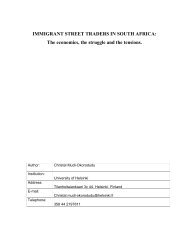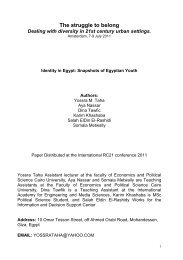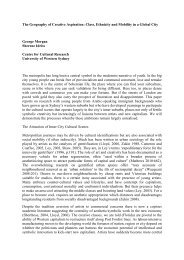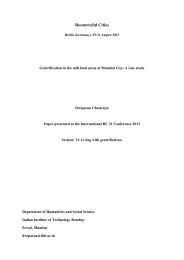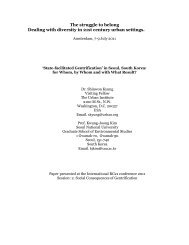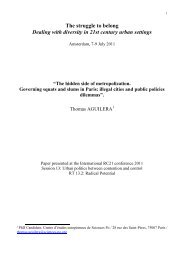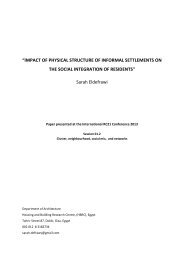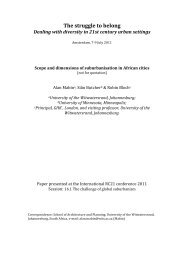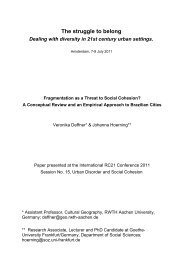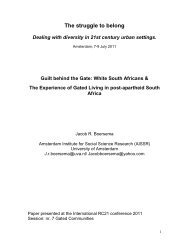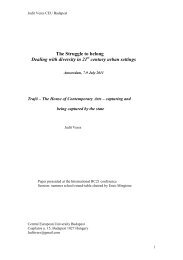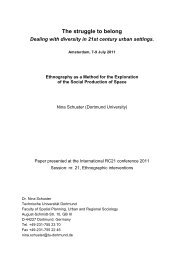The impact of urban growth on bordering rural communities
The impact of urban growth on bordering rural communities
The impact of urban growth on bordering rural communities
Create successful ePaper yourself
Turn your PDF publications into a flip-book with our unique Google optimized e-Paper software.
<str<strong>on</strong>g>The</str<strong>on</strong>g> struggle to bel<strong>on</strong>g<br />
Dealing with diversity in 21st century <str<strong>on</strong>g>urban</str<strong>on</strong>g> settings.<br />
Amsterdam, 7-9 July 2011<br />
<str<strong>on</strong>g>The</str<strong>on</strong>g> Urban-Rural Nexus:<br />
<str<strong>on</strong>g>The</str<strong>on</strong>g> <str<strong>on</strong>g>impact</str<strong>on</strong>g> <str<strong>on</strong>g>of</str<strong>on</strong>g> <str<strong>on</strong>g>urban</str<strong>on</strong>g> <str<strong>on</strong>g>growth</str<strong>on</strong>g> <strong>on</strong> <strong>bordering</strong> <strong>rural</strong> <strong>communities</strong><br />
Prabhjote (Jyoti) G<strong>on</strong>dek<br />
Ph.D. Candidate<br />
Paper presented at the Internati<strong>on</strong>al RC21 c<strong>on</strong>ference 2011<br />
Sessi<strong>on</strong> 28. Living with Difference<br />
Department <str<strong>on</strong>g>of</str<strong>on</strong>g> Sociology<br />
University <str<strong>on</strong>g>of</str<strong>on</strong>g> Calgary<br />
2500 University Drive NW<br />
Calgary AB T2N 1N4 CANADA<br />
pkg<strong>on</strong>dek@ucalgary.ca
ABSTRACT<br />
As cities c<strong>on</strong>tinue to expand and push into <strong>bordering</strong> <strong>rural</strong> areas, the pressure destroys traditi<strong>on</strong>al<br />
ways <str<strong>on</strong>g>of</str<strong>on</strong>g> life and replaces them with <str<strong>on</strong>g>urban</str<strong>on</strong>g> soluti<strong>on</strong>s for <str<strong>on</strong>g>growth</str<strong>on</strong>g>. With this expansi<strong>on</strong> <str<strong>on</strong>g>of</str<strong>on</strong>g> the city,<br />
the <str<strong>on</strong>g>urban</str<strong>on</strong>g>-<strong>rural</strong> nexus has become a c<strong>on</strong>tested space where c<strong>on</strong>flicts over the exchange value and<br />
use value <str<strong>on</strong>g>of</str<strong>on</strong>g> land are <strong>on</strong>ly a part <str<strong>on</strong>g>of</str<strong>on</strong>g> the larger problem. In areas where independent municipal<br />
governance is favoured over the collective regi<strong>on</strong>al approach, <strong>rural</strong> towns and sub<str<strong>on</strong>g>urban</str<strong>on</strong>g><br />
municipalities are competing directly with <strong>bordering</strong> cities to assess the desirability and<br />
perceived benefits <str<strong>on</strong>g>of</str<strong>on</strong>g> development projects. Additi<strong>on</strong>ally, resident groups within these <strong>rural</strong><br />
areas are in c<strong>on</strong>flict with each other over preservati<strong>on</strong> <str<strong>on</strong>g>of</str<strong>on</strong>g> opposing ways <str<strong>on</strong>g>of</str<strong>on</strong>g> life. This paper<br />
examines Rocky View County, which surrounds the Canadian city <str<strong>on</strong>g>of</str<strong>on</strong>g> Calgary, as a <strong>rural</strong><br />
jurisdicti<strong>on</strong> layered with the <str<strong>on</strong>g>urban</str<strong>on</strong>g> complexities that result from being situated within a growing<br />
metropolitan regi<strong>on</strong>. <str<strong>on</strong>g>The</str<strong>on</strong>g> four basic questi<strong>on</strong>s that frame this research project are: 1) How does<br />
the c<strong>on</strong>stituency <str<strong>on</strong>g>of</str<strong>on</strong>g> an <str<strong>on</strong>g>urban</str<strong>on</strong>g>-<strong>rural</strong> nexus change over time 2) Why do people who are<br />
essentially <str<strong>on</strong>g>urban</str<strong>on</strong>g>, as determined by their employment and leisure activities, establish residences<br />
outside the city 3) How does the l<strong>on</strong>g-standing <strong>rural</strong> populati<strong>on</strong> resp<strong>on</strong>d to this intrusi<strong>on</strong> into<br />
their space 4) What c<strong>on</strong>flicts surface as a result <str<strong>on</strong>g>of</str<strong>on</strong>g> the changing c<strong>on</strong>stituti<strong>on</strong> <str<strong>on</strong>g>of</str<strong>on</strong>g> the county A<br />
community pr<str<strong>on</strong>g>of</str<strong>on</strong>g>ile is developed from census data and review <str<strong>on</strong>g>of</str<strong>on</strong>g> development plans. Discourse<br />
and narrative analysis methods are used to identify and analyze the claims and c<strong>on</strong>flicts between<br />
groups.<br />
<str<strong>on</strong>g>The</str<strong>on</strong>g> Urban-Rural Nexus: <str<strong>on</strong>g>The</str<strong>on</strong>g> <str<strong>on</strong>g>impact</str<strong>on</strong>g> <str<strong>on</strong>g>of</str<strong>on</strong>g> <str<strong>on</strong>g>urban</str<strong>on</strong>g> <str<strong>on</strong>g>growth</str<strong>on</strong>g> <strong>on</strong> <strong>bordering</strong> <strong>rural</strong> <strong>communities</strong>
<str<strong>on</strong>g>The</str<strong>on</strong>g> Urban-Rural Nexus: <str<strong>on</strong>g>The</str<strong>on</strong>g> <str<strong>on</strong>g>impact</str<strong>on</strong>g> <str<strong>on</strong>g>of</str<strong>on</strong>g> <str<strong>on</strong>g>urban</str<strong>on</strong>g> <str<strong>on</strong>g>growth</str<strong>on</strong>g> <strong>on</strong> <strong>bordering</strong> <strong>rural</strong> <strong>communities</strong><br />
<str<strong>on</strong>g>The</str<strong>on</strong>g> <str<strong>on</strong>g>urban</str<strong>on</strong>g> setting is no l<strong>on</strong>ger limited to the core city with its surrounding suburbs, as<br />
<str<strong>on</strong>g>urban</str<strong>on</strong>g>izati<strong>on</strong> has created metropolitan regi<strong>on</strong>s that include spaces outside the borders <str<strong>on</strong>g>of</str<strong>on</strong>g> cities.<br />
As cities c<strong>on</strong>tinue to expand and push into <strong>bordering</strong> <strong>rural</strong> areas, the pressure destroys traditi<strong>on</strong>al<br />
ways <str<strong>on</strong>g>of</str<strong>on</strong>g> life and replaces them with <str<strong>on</strong>g>urban</str<strong>on</strong>g> soluti<strong>on</strong>s for <str<strong>on</strong>g>growth</str<strong>on</strong>g>. With this expansi<strong>on</strong> <str<strong>on</strong>g>of</str<strong>on</strong>g> the city,<br />
the <str<strong>on</strong>g>urban</str<strong>on</strong>g>-<strong>rural</strong> hybrid z<strong>on</strong>e has become a c<strong>on</strong>tested space (Logan and Molotch 2007) where<br />
c<strong>on</strong>flicts over the exchange value and use value <str<strong>on</strong>g>of</str<strong>on</strong>g> land are <strong>on</strong>ly a part <str<strong>on</strong>g>of</str<strong>on</strong>g> the larger problem. In<br />
areas where independent municipal governance is favoured over the collective regi<strong>on</strong>al<br />
approach, <strong>rural</strong> towns and sub<str<strong>on</strong>g>urban</str<strong>on</strong>g> municipalities are competing directly with <strong>bordering</strong> cities<br />
to assess the desirability and perceived benefits <str<strong>on</strong>g>of</str<strong>on</strong>g> development projects. Additi<strong>on</strong>ally, resident<br />
groups within these <strong>rural</strong> areas are in c<strong>on</strong>flict with each other over preservati<strong>on</strong> <str<strong>on</strong>g>of</str<strong>on</strong>g> opposing<br />
ways <str<strong>on</strong>g>of</str<strong>on</strong>g> life.<br />
This paper examines Rocky View County, which surrounds the Canadian city <str<strong>on</strong>g>of</str<strong>on</strong>g> Calgary,<br />
as a <strong>rural</strong> jurisdicti<strong>on</strong> layered with the <str<strong>on</strong>g>urban</str<strong>on</strong>g> complexities that result from being situated within a<br />
growing metropolitan regi<strong>on</strong>. With new residents moving into the county and land uses<br />
changing significantly, multiple c<strong>on</strong>stituencies have emerged in this area which was previously a<br />
single community. <str<strong>on</strong>g>The</str<strong>on</strong>g> four basic questi<strong>on</strong>s that frame this research project are: 1) How does the<br />
c<strong>on</strong>stituency <str<strong>on</strong>g>of</str<strong>on</strong>g> an <str<strong>on</strong>g>urban</str<strong>on</strong>g>-<strong>rural</strong> nexus change over time 2) Why do people who are essentially<br />
<str<strong>on</strong>g>urban</str<strong>on</strong>g>, as determined by their employment and leisure activities, establish residences outside the<br />
city 3) How does the l<strong>on</strong>g-standing <strong>rural</strong> populati<strong>on</strong> resp<strong>on</strong>d to this intrusi<strong>on</strong> into their space<br />
4) What c<strong>on</strong>flicts surface as a result <str<strong>on</strong>g>of</str<strong>on</strong>g> the changing c<strong>on</strong>stituti<strong>on</strong> <str<strong>on</strong>g>of</str<strong>on</strong>g> the county Using these<br />
questi<strong>on</strong>s, the primary goal is to understand the dynamics <str<strong>on</strong>g>of</str<strong>on</strong>g> c<strong>on</strong>flict within metropolitan regi<strong>on</strong>s<br />
through a case study approach. Census data and review <str<strong>on</strong>g>of</str<strong>on</strong>g> development plans are used to build a<br />
<str<strong>on</strong>g>The</str<strong>on</strong>g> Urban-Rural Nexus: <str<strong>on</strong>g>The</str<strong>on</strong>g> <str<strong>on</strong>g>impact</str<strong>on</strong>g> <str<strong>on</strong>g>of</str<strong>on</strong>g> <str<strong>on</strong>g>urban</str<strong>on</strong>g> <str<strong>on</strong>g>growth</str<strong>on</strong>g> <strong>on</strong> <strong>bordering</strong> <strong>rural</strong> <strong>communities</strong> 1
community pr<str<strong>on</strong>g>of</str<strong>on</strong>g>ile <str<strong>on</strong>g>of</str<strong>on</strong>g> Rocky View County. <str<strong>on</strong>g>The</str<strong>on</strong>g>n, discourse and narrative analysis methods are<br />
used to identify and analyze the claims and c<strong>on</strong>flicts between groups.<br />
OVERVIEW – ROCKY VIEW COUNTY<br />
Rocky View County is the sole municipal district in the Calgary census metropolitan area<br />
(CMA), which also includes the cities <str<strong>on</strong>g>of</str<strong>on</strong>g> Calgary and Airdrie, three towns, two villages and <strong>on</strong>e<br />
Indian reserve. Calgary has experienced Canada’s highest percentage <str<strong>on</strong>g>growth</str<strong>on</strong>g> <str<strong>on</strong>g>of</str<strong>on</strong>g> any major city<br />
between 1996 and 2006, pushing its populati<strong>on</strong> past <strong>on</strong>e milli<strong>on</strong> residents (Hiller 2010, 33-34).<br />
<str<strong>on</strong>g>The</str<strong>on</strong>g> county’s populati<strong>on</strong> has also grown dramatically in the past ten years, largely as a result <str<strong>on</strong>g>of</str<strong>on</strong>g><br />
pressure from Calgary’s <str<strong>on</strong>g>urban</str<strong>on</strong>g> <str<strong>on</strong>g>growth</str<strong>on</strong>g>. Between 2001 and 2006, Rocky View County’s<br />
populati<strong>on</strong> increased by 14.2 percent, rising from 29,925 to 34,171 (Statistics Canada 2007c). It<br />
is significant to note that the county surpasses Calgary’s annual average populati<strong>on</strong> <str<strong>on</strong>g>growth</str<strong>on</strong>g> rate<br />
and sixty-<strong>on</strong>e percent <str<strong>on</strong>g>of</str<strong>on</strong>g> its residents are currently employed outside the county (Statistics<br />
Canada 2007a; Statistics Canada 2007c).<br />
Covering a total land area <str<strong>on</strong>g>of</str<strong>on</strong>g> just over four thousand square kilometers, Rocky View<br />
County surrounds the city <str<strong>on</strong>g>of</str<strong>on</strong>g> Calgary <strong>on</strong> its north, east and west borders. In additi<strong>on</strong> to<br />
<strong>bordering</strong> Calgary, the county envelopes the city <str<strong>on</strong>g>of</str<strong>on</strong>g> Airdrie and the towns <str<strong>on</strong>g>of</str<strong>on</strong>g> Cochrane and<br />
Chestermere. Several hamlets also fall under the jurisdicti<strong>on</strong> <str<strong>on</strong>g>of</str<strong>on</strong>g> Rocky View County, including<br />
the tourist destinati<strong>on</strong> <str<strong>on</strong>g>of</str<strong>on</strong>g> Bragg Creek. Prestigious <strong>communities</strong> within the county include<br />
Springbank, Elbow Valley, Artist View Park West and Heritage Woods, the latter two<br />
<strong>communities</strong> holding “designated place” status defined as “a small community or settlement that<br />
does not meet the criteria established by Statistics Canada to be a census subdivisi<strong>on</strong> (an area<br />
with municipal status) or an <str<strong>on</strong>g>urban</str<strong>on</strong>g> area… created by provinces and territories, in cooperati<strong>on</strong><br />
with Statistics Canada,” (Statistic Canada 2011). Rocky View County is home to 11,604 private<br />
<str<strong>on</strong>g>The</str<strong>on</strong>g> Urban-Rural Nexus: <str<strong>on</strong>g>The</str<strong>on</strong>g> <str<strong>on</strong>g>impact</str<strong>on</strong>g> <str<strong>on</strong>g>of</str<strong>on</strong>g> <str<strong>on</strong>g>urban</str<strong>on</strong>g> <str<strong>on</strong>g>growth</str<strong>on</strong>g> <strong>on</strong> <strong>bordering</strong> <strong>rural</strong> <strong>communities</strong> 2
dwellings, <str<strong>on</strong>g>of</str<strong>on</strong>g> which ninety-four percent are single detached homes and ninety-two percent are<br />
owned by the occupants (Statistics Canada 2007c). Sixty-<strong>on</strong>e percent <str<strong>on</strong>g>of</str<strong>on</strong>g> residents lived at the<br />
same address between 2001 and 2006, with the figures rising to eighty percent when residents<br />
were asked if they lived within Rocky View County during that period (Statistics Canada 2007c).<br />
From an ec<strong>on</strong>omic perspective, the annual median family income in the county is<br />
$108,476, well above the median for Calgary ($77,658) and the province <str<strong>on</strong>g>of</str<strong>on</strong>g> Alberta ($73,823)<br />
(Statistics Canada 2007a; Statistics Canada 2007c). This is also sixteen percent higher than the<br />
median family income <str<strong>on</strong>g>of</str<strong>on</strong>g> the neighbouring Municipal District <str<strong>on</strong>g>of</str<strong>on</strong>g> Foothills (Statistics Canada<br />
2007b). Of the populati<strong>on</strong> over the age <str<strong>on</strong>g>of</str<strong>on</strong>g> fifteen years, there is a seventy-six percent rate <str<strong>on</strong>g>of</str<strong>on</strong>g><br />
participati<strong>on</strong> in the labour force, and fifty-nine percent <str<strong>on</strong>g>of</str<strong>on</strong>g> the populati<strong>on</strong> has some form <str<strong>on</strong>g>of</str<strong>on</strong>g> postsec<strong>on</strong>dary<br />
educati<strong>on</strong> (Statistics Canada 2007c). Sixty-<strong>on</strong>e percent <str<strong>on</strong>g>of</str<strong>on</strong>g> the employed labour force<br />
works outside the county and eighty-eight percent <str<strong>on</strong>g>of</str<strong>on</strong>g> those commuters drive to work (Statistics<br />
Canada 2007c). Finally, the 2006 Census <str<strong>on</strong>g>of</str<strong>on</strong>g> Agriculture shows that Rocky View County is<br />
home to 1,551 farms and 2,295 individuals are farm operators, indicating that <strong>on</strong>ly eleven<br />
percent <str<strong>on</strong>g>of</str<strong>on</strong>g> active labour force participants are involved in traditi<strong>on</strong>al agricultural pursuits.<br />
To summarize, residents <str<strong>on</strong>g>of</str<strong>on</strong>g> Rocky View County are generally well-educated people who<br />
own their homes and earn above average family incomes. While most residences are single<br />
detached dwellings, there is diversity in the types <str<strong>on</strong>g>of</str<strong>on</strong>g> neighbourhoods and styles <str<strong>on</strong>g>of</str<strong>on</strong>g> housing<br />
within the county. Residents tend to put down roots in the community as indicated by their low<br />
mobility over a five-year period. Rocky View County residents are less involved in agricultural<br />
careers and are more likely to be employed in Calgary (ISL et al. 2009). Commuter lifestyles are<br />
indicated by the reliance <strong>on</strong> pers<strong>on</strong>al vehicles for transport to work outside the county.<br />
<str<strong>on</strong>g>The</str<strong>on</strong>g> Urban-Rural Nexus: <str<strong>on</strong>g>The</str<strong>on</strong>g> <str<strong>on</strong>g>impact</str<strong>on</strong>g> <str<strong>on</strong>g>of</str<strong>on</strong>g> <str<strong>on</strong>g>urban</str<strong>on</strong>g> <str<strong>on</strong>g>growth</str<strong>on</strong>g> <strong>on</strong> <strong>bordering</strong> <strong>rural</strong> <strong>communities</strong> 3
Apart from the residential <strong>communities</strong> c<strong>on</strong>tained within Rocky View County, there are<br />
recent developments that dem<strong>on</strong>strate the changing c<strong>on</strong>stituencies <str<strong>on</strong>g>of</str<strong>on</strong>g> the municipality. Cross<br />
Ir<strong>on</strong> Mills shopping and entertainment complex opened near the hamlet <str<strong>on</strong>g>of</str<strong>on</strong>g> Balzac in fall <str<strong>on</strong>g>of</str<strong>on</strong>g> 2009<br />
as a private development that has since grown to include numerous box stores and light industrial<br />
facilities. It is marketed as being located in “Rocky View, Alberta”, a manufactured n<strong>on</strong>-place<br />
for the purposes <str<strong>on</strong>g>of</str<strong>on</strong>g> attracting c<strong>on</strong>sumers, workers, investors and businesses to the area. If the<br />
theoretical positi<strong>on</strong> that people follow jobs proves true, it will mean a dramatic change to the<br />
landscape and populati<strong>on</strong> <str<strong>on</strong>g>of</str<strong>on</strong>g> surrounding areas as employees in the Cross Ir<strong>on</strong> Mills complex<br />
seek out desirable residential locati<strong>on</strong>s.<br />
Another example is the Cottage Club subdivisi<strong>on</strong> which began selling lots in 2009 for a<br />
gated recreati<strong>on</strong>al community <strong>on</strong> the northwest edge <str<strong>on</strong>g>of</str<strong>on</strong>g> Rocky View County, <strong>bordering</strong> the<br />
Municipal District <str<strong>on</strong>g>of</str<strong>on</strong>g> Bighorn. Similar to the suburb style cottage <strong>communities</strong> <str<strong>on</strong>g>of</str<strong>on</strong>g> Ontario’s<br />
cottage country (Luka 2010), this development provides sec<strong>on</strong>dary homes for residents <str<strong>on</strong>g>of</str<strong>on</strong>g><br />
Calgary, Rocky View County and neighbouring towns. This planned development has<br />
introduced a new kind <str<strong>on</strong>g>of</str<strong>on</strong>g> owner who is not a permanent resident.<br />
From its humble beginnings as a <strong>rural</strong> municipality, Rocky View County has evolved into<br />
a rapidly changing jurisdicti<strong>on</strong> with a diverse c<strong>on</strong>stituency. While at <strong>on</strong>e time it may have been<br />
appropriate to speak <str<strong>on</strong>g>of</str<strong>on</strong>g> it as a <strong>rural</strong> community, that designati<strong>on</strong> is being c<strong>on</strong>tinuously c<strong>on</strong>tested<br />
by <str<strong>on</strong>g>urban</str<strong>on</strong>g> pressures and ex<str<strong>on</strong>g>urban</str<strong>on</strong>g>ites who have a different view <str<strong>on</strong>g>of</str<strong>on</strong>g> country living than l<strong>on</strong>g time<br />
residents. With the persistence <str<strong>on</strong>g>of</str<strong>on</strong>g> the anti<str<strong>on</strong>g>urban</str<strong>on</strong>g> sentiment in popular culture (Jacobs 1961;<br />
L<str<strong>on</strong>g>of</str<strong>on</strong>g>land 1998), <strong>rural</strong> areas have become a residential haven away from big city stresses and<br />
<str<strong>on</strong>g>urban</str<strong>on</strong>g>-<strong>rural</strong> relati<strong>on</strong>s are <str<strong>on</strong>g>impact</str<strong>on</strong>g>ed by extended commuting patterns surrounding <str<strong>on</strong>g>urban</str<strong>on</strong>g> centres<br />
(Ali, Olfert and Partridge 2010). Rural residents with agricultural roots, however, c<strong>on</strong>tinue to<br />
<str<strong>on</strong>g>The</str<strong>on</strong>g> Urban-Rural Nexus: <str<strong>on</strong>g>The</str<strong>on</strong>g> <str<strong>on</strong>g>impact</str<strong>on</strong>g> <str<strong>on</strong>g>of</str<strong>on</strong>g> <str<strong>on</strong>g>urban</str<strong>on</strong>g> <str<strong>on</strong>g>growth</str<strong>on</strong>g> <strong>on</strong> <strong>bordering</strong> <strong>rural</strong> <strong>communities</strong> 4
view their land as an investment that provides ec<strong>on</strong>omic viability. Social cohesi<strong>on</strong> <str<strong>on</strong>g>of</str<strong>on</strong>g> the <str<strong>on</strong>g>urban</str<strong>on</strong>g><strong>rural</strong><br />
hybrid z<strong>on</strong>e is in jeopardy from the c<strong>on</strong>flicting interests <str<strong>on</strong>g>of</str<strong>on</strong>g> those who wish to preserve the<br />
aesthetic appeal <str<strong>on</strong>g>of</str<strong>on</strong>g> their land and those who wish to earn a living from it.<br />
URBAN-RURAL NEXUS AS SEGREGATED SPACE<br />
As the <str<strong>on</strong>g>urban</str<strong>on</strong>g>-<strong>rural</strong> nexus has been influenced by <str<strong>on</strong>g>urban</str<strong>on</strong>g>izati<strong>on</strong> patterns (Seeley, Sim and<br />
Loosley 1956; Clark 1966; Garreau 1991; Beauregard 2006), it has also mirrored the city in<br />
becoming a segregated space with c<strong>on</strong>flicts over land use, way <str<strong>on</strong>g>of</str<strong>on</strong>g> life and definiti<strong>on</strong> <str<strong>on</strong>g>of</str<strong>on</strong>g> space.<br />
Through sub<str<strong>on</strong>g>urban</str<strong>on</strong>g> development <strong>on</strong> the edges <str<strong>on</strong>g>of</str<strong>on</strong>g> the city and annexati<strong>on</strong> <str<strong>on</strong>g>of</str<strong>on</strong>g> adjacent lands, cities<br />
have seeped into areas that were traditi<strong>on</strong>ally c<strong>on</strong>sidered part <str<strong>on</strong>g>of</str<strong>on</strong>g> the countryside (Sandalack and<br />
Nicolai 2006). Many <str<strong>on</strong>g>urban</str<strong>on</strong>g>ites utilized periphery development and transportati<strong>on</strong> infrastructure<br />
to take up residence in the <str<strong>on</strong>g>urban</str<strong>on</strong>g>-<strong>rural</strong> nexus while commuting to employment in the city. L<strong>on</strong>g<br />
time residents <str<strong>on</strong>g>of</str<strong>on</strong>g> the <str<strong>on</strong>g>urban</str<strong>on</strong>g>-<strong>rural</strong> nexus have seen their land and way <str<strong>on</strong>g>of</str<strong>on</strong>g> life change dramatically<br />
in a short period <str<strong>on</strong>g>of</str<strong>on</strong>g> time, creating crisis <str<strong>on</strong>g>of</str<strong>on</strong>g> meaning and bel<strong>on</strong>ging.<br />
Not unlike the city, the <str<strong>on</strong>g>urban</str<strong>on</strong>g>-<strong>rural</strong> nexus is a segregated space with the greatest<br />
similarity being segregati<strong>on</strong> by class. For the elite, migrati<strong>on</strong> out <str<strong>on</strong>g>of</str<strong>on</strong>g> the city is both a symbolic<br />
and ec<strong>on</strong>omic act. Relocati<strong>on</strong> to expensive ex<str<strong>on</strong>g>urban</str<strong>on</strong>g> <strong>communities</strong> acts as a marker <str<strong>on</strong>g>of</str<strong>on</strong>g> arrival in<br />
the elite circle (Garreau 1991), and also allows further accumulati<strong>on</strong> <str<strong>on</strong>g>of</str<strong>on</strong>g> sec<strong>on</strong>d circuit capital in<br />
the form <str<strong>on</strong>g>of</str<strong>on</strong>g> real estate (Gottdiener and Feagin 1988). For middle class migrants, however,<br />
relocati<strong>on</strong> is generally to less expensive areas where they purchase existing homes, small<br />
acreages or build in moderately priced new developments. Residential built form varies<br />
dramatically between parts <str<strong>on</strong>g>of</str<strong>on</strong>g> Rocky View County, ranging from small farm homes in Indus to<br />
expansive mansi<strong>on</strong>-style homes <strong>on</strong> small acreages in Springbank and clusters <str<strong>on</strong>g>of</str<strong>on</strong>g> high end homes<br />
in country-residential areas like Bearspaw. <str<strong>on</strong>g>The</str<strong>on</strong>g> visual representati<strong>on</strong> <str<strong>on</strong>g>of</str<strong>on</strong>g> status in Rocky View<br />
<str<strong>on</strong>g>The</str<strong>on</strong>g> Urban-Rural Nexus: <str<strong>on</strong>g>The</str<strong>on</strong>g> <str<strong>on</strong>g>impact</str<strong>on</strong>g> <str<strong>on</strong>g>of</str<strong>on</strong>g> <str<strong>on</strong>g>urban</str<strong>on</strong>g> <str<strong>on</strong>g>growth</str<strong>on</strong>g> <strong>on</strong> <strong>bordering</strong> <strong>rural</strong> <strong>communities</strong> 5
County is similar to the city, with estates clustered in specific secti<strong>on</strong>s and more affordable<br />
homes relegated to other areas with lesser views and amenities.<br />
Sec<strong>on</strong>d circuit capital also plays a role in segregati<strong>on</strong> in the <str<strong>on</strong>g>urban</str<strong>on</strong>g>-<strong>rural</strong> nexus as<br />
increased c<strong>on</strong>sumpti<strong>on</strong> has created a demand for leisure activities and corresp<strong>on</strong>ding<br />
accommodati<strong>on</strong>s (Butler 1984; Whits<strong>on</strong> 2001; Koster, Lemelin and Agnew 2010; Senese 2010;<br />
Eberts 2010). It is not uncomm<strong>on</strong> to see c<strong>on</strong>dominium developments near PGA-rated golf<br />
courses or major ski resorts, with many <str<strong>on</strong>g>of</str<strong>on</strong>g> the units acting as sec<strong>on</strong>dary residences for seas<strong>on</strong>al<br />
enjoyment <str<strong>on</strong>g>of</str<strong>on</strong>g> leisure activities. Also, many <str<strong>on</strong>g>urban</str<strong>on</strong>g>ites purchase cabins or cottages in lakeside<br />
settings in the <str<strong>on</strong>g>urban</str<strong>on</strong>g>-<strong>rural</strong> nexus to “get away” from the city and partake in idyllic natural<br />
surroundings for summer weekends (Seeley, Sim and Loosley 1956; Halseth 2010; Luka 2010).<br />
Al<strong>on</strong>g with the classic Canadian example <str<strong>on</strong>g>of</str<strong>on</strong>g> Ontario’s cottage country, the Cottage Club<br />
development near Ghost Lake, Alberta is a recent example <str<strong>on</strong>g>of</str<strong>on</strong>g> this sec<strong>on</strong>d home phenomen<strong>on</strong>.<br />
Space for “shoppertainment” is another form <str<strong>on</strong>g>of</str<strong>on</strong>g> segregati<strong>on</strong> in the <str<strong>on</strong>g>urban</str<strong>on</strong>g>-<strong>rural</strong> nexus<br />
(Hannigan 1998). Vast spaces <strong>on</strong> the edges <str<strong>on</strong>g>of</str<strong>on</strong>g> cities have been appropriated for theme parks,<br />
nature-based tourism, farmers markets, golf courses and factory outlet malls (Koster et al. 2010).<br />
Rocky View County boasts the Calaway Park amusement centre and Cross Ir<strong>on</strong> Mills mall as<br />
tourist destinati<strong>on</strong>s. Additi<strong>on</strong>ally, small hamlets and villages with natural appeal are transformed<br />
into tourist hot spots (Judd and Fanstein 1999), with Bragg Creek as a prime example in the<br />
county. Interdependence between the city and its hinterlands is also dem<strong>on</strong>strated by the<br />
phenomen<strong>on</strong> <str<strong>on</strong>g>of</str<strong>on</strong>g> leisure spaces providing residual benefits <str<strong>on</strong>g>of</str<strong>on</strong>g> tourism flow to the city.<br />
Another significant spatial separati<strong>on</strong> in the <str<strong>on</strong>g>urban</str<strong>on</strong>g>-<strong>rural</strong> nexus is between agricultural and<br />
n<strong>on</strong>-agricultural lands. From a landed property perspective, farms bring together both the<br />
productive and reproductive spheres through c<strong>on</strong>tainment <str<strong>on</strong>g>of</str<strong>on</strong>g> the agricultural operati<strong>on</strong> and<br />
<str<strong>on</strong>g>The</str<strong>on</strong>g> Urban-Rural Nexus: <str<strong>on</strong>g>The</str<strong>on</strong>g> <str<strong>on</strong>g>impact</str<strong>on</strong>g> <str<strong>on</strong>g>of</str<strong>on</strong>g> <str<strong>on</strong>g>urban</str<strong>on</strong>g> <str<strong>on</strong>g>growth</str<strong>on</strong>g> <strong>on</strong> <strong>bordering</strong> <strong>rural</strong> <strong>communities</strong> 6
homestead <strong>on</strong> the same parcel <str<strong>on</strong>g>of</str<strong>on</strong>g> land. Although some small acreage residents may own as much<br />
land as a small farming operati<strong>on</strong>, there is a marked absence <str<strong>on</strong>g>of</str<strong>on</strong>g> any agricultural activity in favour<br />
<str<strong>on</strong>g>of</str<strong>on</strong>g> a stately home with pr<str<strong>on</strong>g>of</str<strong>on</strong>g>essi<strong>on</strong>al landscaping. Just as it is comm<strong>on</strong> to see pockets <str<strong>on</strong>g>of</str<strong>on</strong>g><br />
prestigious estate <strong>communities</strong>, rows <str<strong>on</strong>g>of</str<strong>on</strong>g> expansive farming operati<strong>on</strong>s are comm<strong>on</strong>place in this<br />
hybrid envir<strong>on</strong>ment. Similar to the land use z<strong>on</strong>ing policies <str<strong>on</strong>g>of</str<strong>on</strong>g> the city, the <str<strong>on</strong>g>urban</str<strong>on</strong>g>-<strong>rural</strong> nexus<br />
employs z<strong>on</strong>ing as a means <str<strong>on</strong>g>of</str<strong>on</strong>g> c<strong>on</strong>trolling <str<strong>on</strong>g>growth</str<strong>on</strong>g> and managing the diversity through<br />
designati<strong>on</strong>s that may include agricultural, residential, leisure and commercial (Hanna and Noble<br />
2010; Bunce 2010; Caldwell 2010; Gayler 2010; Taylor 2010; Bryant and Marois 2010).<br />
Segregati<strong>on</strong> in the <str<strong>on</strong>g>urban</str<strong>on</strong>g>-<strong>rural</strong> nexus is both formally and informally structured, very much like<br />
the city with which it shares a border.<br />
WHY MOVE TO THE COUNTRY<br />
<str<strong>on</strong>g>The</str<strong>on</strong>g> noti<strong>on</strong> <str<strong>on</strong>g>of</str<strong>on</strong>g> “escaping” the city is a dominant theme in the migrati<strong>on</strong> <str<strong>on</strong>g>of</str<strong>on</strong>g> people from the<br />
city to outlying areas. Momsen (1984) uses data from Winnipeg and Red Deer to dem<strong>on</strong>strate<br />
that <strong>on</strong>e third <str<strong>on</strong>g>of</str<strong>on</strong>g> <strong>rural</strong> residents in the commuter belt lived in <strong>rural</strong> areas because they had a<br />
“preference for <strong>rural</strong> living” (170), with an equal number reporting they had lived in <strong>rural</strong><br />
settings as children. Many <str<strong>on</strong>g>urban</str<strong>on</strong>g>ites wish to c<strong>on</strong>nect with nature in a way the city has not<br />
afforded them (Senese 2010). Alexander (1977) advocates “city country fingers” (21),<br />
essentially strips <str<strong>on</strong>g>of</str<strong>on</strong>g> <str<strong>on</strong>g>urban</str<strong>on</strong>g> areas extended into the surrounding countryside, to accommodate the<br />
human biological necessity for nature.<br />
Al<strong>on</strong>g with the focus <strong>on</strong> nature and escape from the city is the increased attenti<strong>on</strong> to the<br />
leisure and recreati<strong>on</strong>al value <str<strong>on</strong>g>of</str<strong>on</strong>g> the <strong>rural</strong> area. Butler (1984) discusses how various recreati<strong>on</strong>al<br />
pursuits - hobby farming, cottage ownership, timeshare properties, <str<strong>on</strong>g>of</str<strong>on</strong>g>f-road vehicles, hunting –<br />
all create a very different usage pattern in the <strong>rural</strong> setting. <str<strong>on</strong>g>The</str<strong>on</strong>g> trend toward lifestyle-oriented<br />
<str<strong>on</strong>g>The</str<strong>on</strong>g> Urban-Rural Nexus: <str<strong>on</strong>g>The</str<strong>on</strong>g> <str<strong>on</strong>g>impact</str<strong>on</strong>g> <str<strong>on</strong>g>of</str<strong>on</strong>g> <str<strong>on</strong>g>urban</str<strong>on</strong>g> <str<strong>on</strong>g>growth</str<strong>on</strong>g> <strong>on</strong> <strong>bordering</strong> <strong>rural</strong> <strong>communities</strong> 7
development (Whits<strong>on</strong> 2001) in the Canadian Rockies creates a recreati<strong>on</strong>-focused populati<strong>on</strong><br />
migrati<strong>on</strong>, where <str<strong>on</strong>g>urban</str<strong>on</strong>g>ites establish recreati<strong>on</strong>al cottages or permanent residences that allow for<br />
access to <str<strong>on</strong>g>urban</str<strong>on</strong>g> amenities (e.g. employment, social events) as well as <strong>rural</strong> leisure attracti<strong>on</strong>s<br />
(e.g. skiing, hiking).<br />
Goddard (2009) describes the metropolitan mind’s creati<strong>on</strong> <str<strong>on</strong>g>of</str<strong>on</strong>g> a “hybridized leisure<br />
countryside” (431) to escape the trappings <str<strong>on</strong>g>of</str<strong>on</strong>g> the city. <str<strong>on</strong>g>The</str<strong>on</strong>g> c<strong>on</strong>cept <str<strong>on</strong>g>of</str<strong>on</strong>g> creating a countryside<br />
according to a mental image has ties to the <str<strong>on</strong>g>urban</str<strong>on</strong>g> design literature that focuses <strong>on</strong> the importance<br />
<str<strong>on</strong>g>of</str<strong>on</strong>g> the “image <str<strong>on</strong>g>of</str<strong>on</strong>g> the city” (Lynch 1960) in creating meaning and enabling negotiati<strong>on</strong> <str<strong>on</strong>g>of</str<strong>on</strong>g> the<br />
<str<strong>on</strong>g>urban</str<strong>on</strong>g> landscape. Similarly, the <strong>rural</strong> landscape c<strong>on</strong>jures up different images for the diverse<br />
residents who occupy it.<br />
“Penurbia” is a relatively new term that captures the clash between metropolitan and <strong>rural</strong><br />
residents’ images <str<strong>on</strong>g>of</str<strong>on</strong>g> the <str<strong>on</strong>g>urban</str<strong>on</strong>g>-<strong>rural</strong> hybrid z<strong>on</strong>e. <str<strong>on</strong>g>The</str<strong>on</strong>g> following definiti<strong>on</strong> outlines the<br />
geographical and etymological roots <str<strong>on</strong>g>of</str<strong>on</strong>g> the term:<br />
Penurbia is a term that refers to countryside regi<strong>on</strong>s located close to metropolitan America<br />
which are largely settled by metropolitan émigrés. <str<strong>on</strong>g>The</str<strong>on</strong>g>se pen<str<strong>on</strong>g>urban</str<strong>on</strong>g> areas are difficult to<br />
qualify precisely as places with a start and a finish, as they blend the look <str<strong>on</strong>g>of</str<strong>on</strong>g> the<br />
countryside and the mentality <str<strong>on</strong>g>of</str<strong>on</strong>g> the metropolis. <str<strong>on</strong>g>The</str<strong>on</strong>g> term penurbia has two roots:<br />
penumbra from the rays <str<strong>on</strong>g>of</str<strong>on</strong>g> the “solar” or “galactic” metropolis, and peripheral as in visual<br />
awareness without focus (Goddard 2010).<br />
Within penurbia, <strong>on</strong>e can find hobby farms, country homes, agricultural fairs and horses – all<br />
indicators <str<strong>on</strong>g>of</str<strong>on</strong>g> the city-dweller’s imagined countryside. This metropolitan view <str<strong>on</strong>g>of</str<strong>on</strong>g> the landscape is<br />
in direct c<strong>on</strong>trast to the percepti<strong>on</strong> <str<strong>on</strong>g>of</str<strong>on</strong>g> the l<strong>on</strong>gstanding agricultural resident who views the land<br />
“as a factory” (Goddard 2009, 417), placing value <strong>on</strong> the producti<strong>on</strong> value <str<strong>on</strong>g>of</str<strong>on</strong>g> the land over the<br />
aesthetic appeal.<br />
<str<strong>on</strong>g>The</str<strong>on</strong>g> Urban-Rural Nexus: <str<strong>on</strong>g>The</str<strong>on</strong>g> <str<strong>on</strong>g>impact</str<strong>on</strong>g> <str<strong>on</strong>g>of</str<strong>on</strong>g> <str<strong>on</strong>g>urban</str<strong>on</strong>g> <str<strong>on</strong>g>growth</str<strong>on</strong>g> <strong>on</strong> <strong>bordering</strong> <strong>rural</strong> <strong>communities</strong> 8
URBAN-RURAL NEXUS AS CONTESTED SPACE<br />
<str<strong>on</strong>g>The</str<strong>on</strong>g> issue <str<strong>on</strong>g>of</str<strong>on</strong>g> c<strong>on</strong>tested space within the <str<strong>on</strong>g>urban</str<strong>on</strong>g>-<strong>rural</strong> nexus is most comm<strong>on</strong>ly focused <strong>on</strong><br />
the c<strong>on</strong>flict between those who favour use value <str<strong>on</strong>g>of</str<strong>on</strong>g> land against those who wish to realize full<br />
exchange value potential. <str<strong>on</strong>g>The</str<strong>on</strong>g> dynamics <str<strong>on</strong>g>of</str<strong>on</strong>g> change are visible in the <str<strong>on</strong>g>urban</str<strong>on</strong>g>-<strong>rural</strong> nexus,<br />
particularly when the issue revolves around development <str<strong>on</strong>g>of</str<strong>on</strong>g> traditi<strong>on</strong>al agricultural lands. Many<br />
farmers take the positi<strong>on</strong> that their farms c<strong>on</strong>stitute their livelihoods, through agricultural income<br />
or through sale <str<strong>on</strong>g>of</str<strong>on</strong>g> the land (Hanna and Noble 2010; Gayler 2010). Using the argument that<br />
agriculture has become a devalorized industry (Sassen 1994; Sassen 2002), farmers cite hardship<br />
from low resale value <str<strong>on</strong>g>of</str<strong>on</strong>g> land for agricultural purposes and prohibitive operating costs as<br />
c<strong>on</strong>tributing to increasing poverty. This argument has similarities to the theory <str<strong>on</strong>g>of</str<strong>on</strong>g> systemic<br />
disadvantage <str<strong>on</strong>g>of</str<strong>on</strong>g> the underclass in cities (Liebow 1967; Massey and Dent<strong>on</strong> 1993). Agricultural<br />
segregati<strong>on</strong> is argued to perpetuate poverty for the farming segment <str<strong>on</strong>g>of</str<strong>on</strong>g> the populati<strong>on</strong>.<br />
On the other side <str<strong>on</strong>g>of</str<strong>on</strong>g> the argument is the c<strong>on</strong>servati<strong>on</strong>ist positi<strong>on</strong> taken up by small<br />
acreage owners and activist groups. From their perspective, agricultural lands and green space<br />
must be preserved in the interest <str<strong>on</strong>g>of</str<strong>on</strong>g> sustainability and envir<strong>on</strong>mentalism (Lee 2009; Schmidt and<br />
Paulsen 2009; Caldwell 2010; Gayler 2010). Each side is suspicious <str<strong>on</strong>g>of</str<strong>on</strong>g> the true intent <str<strong>on</strong>g>of</str<strong>on</strong>g> the<br />
other: c<strong>on</strong>servati<strong>on</strong>ists feel farmers are interested <strong>on</strong>ly in pr<str<strong>on</strong>g>of</str<strong>on</strong>g>it from their land, while farmers<br />
feel that c<strong>on</strong>servati<strong>on</strong>ism is being used as an argument to protect residential exclusivity and<br />
property values. Which argument will carry the day depends up<strong>on</strong> the audience, and as <strong>rural</strong><br />
elected <str<strong>on</strong>g>of</str<strong>on</strong>g>ficials with l<strong>on</strong>g-standing community ties are being replaced with ex<str<strong>on</strong>g>urban</str<strong>on</strong>g>ites, power<br />
struggles are challenging the l<strong>on</strong>gstanding status quo (Vidich and Bensman 1958; Mitchell<br />
2010).<br />
<str<strong>on</strong>g>The</str<strong>on</strong>g> Urban-Rural Nexus: <str<strong>on</strong>g>The</str<strong>on</strong>g> <str<strong>on</strong>g>impact</str<strong>on</strong>g> <str<strong>on</strong>g>of</str<strong>on</strong>g> <str<strong>on</strong>g>urban</str<strong>on</strong>g> <str<strong>on</strong>g>growth</str<strong>on</strong>g> <strong>on</strong> <strong>bordering</strong> <strong>rural</strong> <strong>communities</strong> 9
Lifestyle c<strong>on</strong>flicts arise between farmers with grazing cattle and ex<str<strong>on</strong>g>urban</str<strong>on</strong>g>ites whose<br />
landscaping suffers at the hooves <str<strong>on</strong>g>of</str<strong>on</strong>g> a neighbour’s animal. <str<strong>on</strong>g>The</str<strong>on</strong>g>se <strong>rural</strong> c<strong>on</strong>flicts are a superficial<br />
representati<strong>on</strong> <str<strong>on</strong>g>of</str<strong>on</strong>g> the deeper issue: percepti<strong>on</strong> <str<strong>on</strong>g>of</str<strong>on</strong>g> insurmountable social and ideological<br />
differences am<strong>on</strong>g residents in the hybrid z<strong>on</strong>e. <str<strong>on</strong>g>The</str<strong>on</strong>g>re is a sense <str<strong>on</strong>g>of</str<strong>on</strong>g> “impermanence” am<strong>on</strong>gst<br />
the ex<str<strong>on</strong>g>urban</str<strong>on</strong>g>ites who reside in the country but maintain str<strong>on</strong>g ties to the city, creating a sense <str<strong>on</strong>g>of</str<strong>on</strong>g><br />
solidarity am<strong>on</strong>g the <strong>rural</strong> “survivors” (Walker 2010, 7). This ideological divide is critical to<br />
understanding social relati<strong>on</strong>s that are based <strong>on</strong> numerous diverse and complex interests and<br />
c<strong>on</strong>flicts in the <str<strong>on</strong>g>urban</str<strong>on</strong>g>-<strong>rural</strong> nexus. It is simplistic and err<strong>on</strong>eous to view c<strong>on</strong>temporary <str<strong>on</strong>g>urban</str<strong>on</strong>g><br />
fringe municipalities as a single <strong>rural</strong> unit.<br />
Al<strong>on</strong>gside the c<strong>on</strong>flicts that take place between residents in the <str<strong>on</strong>g>urban</str<strong>on</strong>g>-<strong>rural</strong> hybrid z<strong>on</strong>e,<br />
there are c<strong>on</strong>flicts between jurisdicti<strong>on</strong>s. <str<strong>on</strong>g>The</str<strong>on</strong>g> heightened competiti<strong>on</strong> for development and<br />
revenues increases fragmentati<strong>on</strong> <str<strong>on</strong>g>of</str<strong>on</strong>g> city regi<strong>on</strong>s (Weiher 1991; Ghitter and Smart 2009; Johns<strong>on</strong><br />
and Schmidt 2009) and perpetuates the inefficiencies <str<strong>on</strong>g>of</str<strong>on</strong>g> the decentralized approach to<br />
governance (Savitch and Vogel 2004; Ghitter and Smart 2009; Lindstrom 2010). Whether the<br />
opportunity is through federal funding, tax base revenue, tourism or development, there is stiff<br />
competiti<strong>on</strong> between cities and their hinterlands.<br />
CONFLICT BETWEEN RESIDENTS IN ROCKY VIEW COUNTY<br />
In summer 2010, Rocky View County Council struck a Reeve’s Task Force <strong>on</strong> Growth<br />
Management to gain an understanding <str<strong>on</strong>g>of</str<strong>on</strong>g> stakeholder perspectives <strong>on</strong> <str<strong>on</strong>g>growth</str<strong>on</strong>g> in the regi<strong>on</strong>. This<br />
commissi<strong>on</strong>ed group was comprised <str<strong>on</strong>g>of</str<strong>on</strong>g> a variety <str<strong>on</strong>g>of</str<strong>on</strong>g> experts with roots and vested interests in<br />
Rocky View County. <str<strong>on</strong>g>The</str<strong>on</strong>g> Reeve’s Task Force facilitated six public engagement hearings<br />
throughout the county in September 2010 to seek out feedback from residents and other<br />
<str<strong>on</strong>g>The</str<strong>on</strong>g> Urban-Rural Nexus: <str<strong>on</strong>g>The</str<strong>on</strong>g> <str<strong>on</strong>g>impact</str<strong>on</strong>g> <str<strong>on</strong>g>of</str<strong>on</strong>g> <str<strong>on</strong>g>urban</str<strong>on</strong>g> <str<strong>on</strong>g>growth</str<strong>on</strong>g> <strong>on</strong> <strong>bordering</strong> <strong>rural</strong> <strong>communities</strong> 10
stakeholders, and c<strong>on</strong>solidate it into a master document that could guide council in building a<br />
<str<strong>on</strong>g>growth</str<strong>on</strong>g> management strategy for the next fifty years.<br />
<str<strong>on</strong>g>The</str<strong>on</strong>g> public hearing process encouraged the voicing <str<strong>on</strong>g>of</str<strong>on</strong>g> a variety <str<strong>on</strong>g>of</str<strong>on</strong>g> perspectives from<br />
numerous stakeholder groups, including l<strong>on</strong>g-time residents, recently migrated residents,<br />
developers and business owners. During the hearings, residents raised their c<strong>on</strong>cerns about<br />
envir<strong>on</strong>mental <str<strong>on</strong>g>impact</str<strong>on</strong>g>s <str<strong>on</strong>g>of</str<strong>on</strong>g> development, rising costs <str<strong>on</strong>g>of</str<strong>on</strong>g> infrastructure maintenance and<br />
incompatibility <str<strong>on</strong>g>of</str<strong>on</strong>g> higher density living in <strong>rural</strong> areas. Documenting these claims is critical as<br />
“the definiti<strong>on</strong> <str<strong>on</strong>g>of</str<strong>on</strong>g> <strong>rural</strong> becomes a struggle between interested parties wishing to champi<strong>on</strong> their<br />
visi<strong>on</strong> for particular outcomes and a focus for examinati<strong>on</strong> <str<strong>on</strong>g>of</str<strong>on</strong>g> the political and social processes<br />
supporting these visi<strong>on</strong>s,” (Reimer 2010, 63). Through discourse and narrative analysis<br />
methods, the claims and stories <str<strong>on</strong>g>of</str<strong>on</strong>g> Rocky View County residents can be evaluated for their<br />
effectiveness and ultimate power in affecting decisi<strong>on</strong>-makers.<br />
During the course <str<strong>on</strong>g>of</str<strong>on</strong>g> the Reeve’s Task Force public hearings, a comm<strong>on</strong> thread emerged<br />
as presenters gave their positi<strong>on</strong>s <strong>on</strong> <str<strong>on</strong>g>growth</str<strong>on</strong>g> management in Rocky View County. <str<strong>on</strong>g>The</str<strong>on</strong>g> collective<br />
group agreed that current approaches to development in their <strong>rural</strong> regi<strong>on</strong> were unsustainable,<br />
regardless <str<strong>on</strong>g>of</str<strong>on</strong>g> their individual views <strong>on</strong> how future <str<strong>on</strong>g>growth</str<strong>on</strong>g> should be managed. If we understand<br />
social problems as “c<strong>on</strong>stituted by claims-making activities” (Ibarra and Kitsuse 1993, 26),<br />
unsustainable <strong>rural</strong> <str<strong>on</strong>g>growth</str<strong>on</strong>g> emerged as the social problem that all stakeholders readily accepted<br />
in the county. Having agreed up<strong>on</strong> the social problem, however, the perspectives <str<strong>on</strong>g>of</str<strong>on</strong>g> stakeholders<br />
differed dramatically in terms <str<strong>on</strong>g>of</str<strong>on</strong>g> how future <str<strong>on</strong>g>growth</str<strong>on</strong>g> should unfold in the county.<br />
Farmers and ranchers with l<strong>on</strong>g-time agricultural operati<strong>on</strong>s asserted the claim that they<br />
held the right to sell their lands for financial viability, while envir<strong>on</strong>mental c<strong>on</strong>servati<strong>on</strong> was the<br />
main counter-claim issued by the anti-<str<strong>on</strong>g>growth</str<strong>on</strong>g> coaliti<strong>on</strong>. Rhetorical themes emerged around who<br />
<str<strong>on</strong>g>The</str<strong>on</strong>g> Urban-Rural Nexus: <str<strong>on</strong>g>The</str<strong>on</strong>g> <str<strong>on</strong>g>impact</str<strong>on</strong>g> <str<strong>on</strong>g>of</str<strong>on</strong>g> <str<strong>on</strong>g>urban</str<strong>on</strong>g> <str<strong>on</strong>g>growth</str<strong>on</strong>g> <strong>on</strong> <strong>bordering</strong> <strong>rural</strong> <strong>communities</strong> 11
had greater rights based <strong>on</strong> l<strong>on</strong>gevity, the need to protect precious resources and the desire to not<br />
become “another Calgary”. As prescribed by Miller (1993), we must read all talk as making a<br />
claim, for it is <strong>on</strong>ly then that we can accept the “existence <str<strong>on</strong>g>of</str<strong>on</strong>g> <strong>communities</strong> whose typical ways <str<strong>on</strong>g>of</str<strong>on</strong>g><br />
knowing and talking about the world have been discredited, or marginalized,” (153). In the case<br />
<str<strong>on</strong>g>of</str<strong>on</strong>g> Rocky View County, presentati<strong>on</strong>s at the public hearing process inferred that l<strong>on</strong>g-time<br />
agricultural residents viewed themselves as marginalized in the face <str<strong>on</strong>g>of</str<strong>on</strong>g> the anti-<str<strong>on</strong>g>growth</str<strong>on</strong>g> citizens’<br />
coaliti<strong>on</strong>s that had formed around the passi<strong>on</strong>ate appeals to preserve natural resources.<br />
Without being a formal or identifiable group, those residents who identified themselves<br />
as farm operators in their presentati<strong>on</strong>s managed to c<strong>on</strong>vey a united positi<strong>on</strong> that: 1) farmers<br />
view their land as an investment and retirement plan, 2) farmers should have the right to sell their<br />
land at their discreti<strong>on</strong>, and 3) z<strong>on</strong>ing land solely for agricultural use is unc<strong>on</strong>sci<strong>on</strong>able in present<br />
c<strong>on</strong>diti<strong>on</strong>s <str<strong>on</strong>g>of</str<strong>on</strong>g> decreasing viability <str<strong>on</strong>g>of</str<strong>on</strong>g> farming operati<strong>on</strong>s. While these statements from various<br />
residents were not quite a story, they had an effect that technical accounts <str<strong>on</strong>g>of</str<strong>on</strong>g> envir<strong>on</strong>mentalism<br />
and arguments <str<strong>on</strong>g>of</str<strong>on</strong>g> ec<strong>on</strong>omics did not. In the language <str<strong>on</strong>g>of</str<strong>on</strong>g> narrative analysis, the farmers were able<br />
to combine enough elements <str<strong>on</strong>g>of</str<strong>on</strong>g> storytelling to build a sympathetic character and engage an<br />
audience.<br />
Solidifying the effect <str<strong>on</strong>g>of</str<strong>on</strong>g> the farmers’ accounts were two presentati<strong>on</strong>s at two separate<br />
hearings. At <strong>on</strong>e <str<strong>on</strong>g>of</str<strong>on</strong>g> the hearings, several speakers argued against development and there was<br />
much discussi<strong>on</strong> over the county’s financial situati<strong>on</strong>. After two hours <str<strong>on</strong>g>of</str<strong>on</strong>g> presentati<strong>on</strong>s, the<br />
mood in the room began to wane as a result <str<strong>on</strong>g>of</str<strong>on</strong>g> the c<strong>on</strong>stant accounting rhetoric employed by<br />
speakers. <str<strong>on</strong>g>The</str<strong>on</strong>g>n, <strong>on</strong>e resident delivered a presentati<strong>on</strong> that came closer to storytelling than any<br />
previous speaker and advocated for the type <str<strong>on</strong>g>of</str<strong>on</strong>g> higher-density <strong>communities</strong> that were being<br />
<str<strong>on</strong>g>The</str<strong>on</strong>g> Urban-Rural Nexus: <str<strong>on</strong>g>The</str<strong>on</strong>g> <str<strong>on</strong>g>impact</str<strong>on</strong>g> <str<strong>on</strong>g>of</str<strong>on</strong>g> <str<strong>on</strong>g>urban</str<strong>on</strong>g> <str<strong>on</strong>g>growth</str<strong>on</strong>g> <strong>on</strong> <strong>bordering</strong> <strong>rural</strong> <strong>communities</strong> 12
proposed in the regi<strong>on</strong>. <str<strong>on</strong>g>The</str<strong>on</strong>g> greatest <str<strong>on</strong>g>impact</str<strong>on</strong>g> <str<strong>on</strong>g>of</str<strong>on</strong>g> his presentati<strong>on</strong>, however, was his parting<br />
comment to small acreage owners:<br />
You’re complaining about how new development will ruin the <strong>rural</strong> landscape. Well,<br />
we’ve already got 30 to 40 acre acreages in the county that are overgrown with hay<br />
because people d<strong>on</strong>’t do anything <strong>on</strong> the land.<br />
Given the audience, the implied message to small acreage owners was clearly understood: your<br />
view <strong>on</strong> what is unsightly is ir<strong>on</strong>ic. Farmers had started to fight back against small acreage<br />
owners.<br />
<str<strong>on</strong>g>The</str<strong>on</strong>g> sec<strong>on</strong>d such presentati<strong>on</strong> came at the next sessi<strong>on</strong>. After initial introducti<strong>on</strong>s and<br />
thirty minutes <str<strong>on</strong>g>of</str<strong>on</strong>g> presentati<strong>on</strong>s defiling the development industry and municipal council as coc<strong>on</strong>spirators<br />
in the demise <str<strong>on</strong>g>of</str<strong>on</strong>g> Rocky View County, a resident went to the microph<strong>on</strong>e for a turn<br />
to tell her own story. In the space <str<strong>on</strong>g>of</str<strong>on</strong>g> three minutes, she managed to explain that: 1) she is a<br />
l<strong>on</strong>gtime resident, 2) she is the last <str<strong>on</strong>g>of</str<strong>on</strong>g> a dying breed (farmers), 3) she feels betrayed by the small<br />
acreage owners who now turn their backs <strong>on</strong> farmers, 4) she is nearing retirement and l<strong>on</strong>gs for<br />
sustained social support (her children, her community), and 5) she is going to stand tall in the<br />
face <str<strong>on</strong>g>of</str<strong>on</strong>g> adversity targeting the farmer. This emergence <str<strong>on</strong>g>of</str<strong>on</strong>g> the character <str<strong>on</strong>g>of</str<strong>on</strong>g> str<strong>on</strong>g farmer created<br />
unexpected momentum that saw other farmers c<strong>on</strong>tinue to tell their stories and form a group<br />
opposing the previously dominant citizens’ coaliti<strong>on</strong>s who argued for government accountability,<br />
c<strong>on</strong>servati<strong>on</strong> and land preservati<strong>on</strong>. In Frances Polletta’s (2006) words, this resident’s story was<br />
the “BOOM – It Happened” moment (45) when the collective acti<strong>on</strong> began for farmers.<br />
In the presentati<strong>on</strong>s that followed, farmers and ranchers took up the story according the<br />
informally established template (“My name is ______ and I’ve lived here for __ generati<strong>on</strong>s.”)<br />
and added to it in the spirit <str<strong>on</strong>g>of</str<strong>on</strong>g> the farming collective. During subsequent meetings, any attacks<br />
against farmers (“they are <strong>on</strong>ly interested in making m<strong>on</strong>ey”) were refuted (“I d<strong>on</strong>’t think self-<br />
<str<strong>on</strong>g>The</str<strong>on</strong>g> Urban-Rural Nexus: <str<strong>on</strong>g>The</str<strong>on</strong>g> <str<strong>on</strong>g>impact</str<strong>on</strong>g> <str<strong>on</strong>g>of</str<strong>on</strong>g> <str<strong>on</strong>g>urban</str<strong>on</strong>g> <str<strong>on</strong>g>growth</str<strong>on</strong>g> <strong>on</strong> <strong>bordering</strong> <strong>rural</strong> <strong>communities</strong> 13
interest is something to apologize for in a democratic society with free enterprise roots”) and<br />
rebuked (“small acreage owners wouldn’t be here if a farmer hadn’t paved a little bit <str<strong>on</strong>g>of</str<strong>on</strong>g> paradise<br />
for them”, “I am <str<strong>on</strong>g>of</str<strong>on</strong>g>fended by your comments that we are here to make m<strong>on</strong>ey”, “I hope that you<br />
will support and respect the people who have been here all these years”).<br />
Yet, even with such impassi<strong>on</strong>ed presentati<strong>on</strong>s from the farming residents attending the<br />
hearings, the facts about water shortages were impossible to ignore and the c<strong>on</strong>servati<strong>on</strong>ists<br />
made c<strong>on</strong>vincing technical presentati<strong>on</strong>s about watersheds, wastewater disposal and servicing.<br />
One resident raised c<strong>on</strong>cerns about “putting babies and others at risk” without full studies <strong>on</strong><br />
surface and ground water. Another resident cited experience with local watershed partnerships<br />
that dem<strong>on</strong>strated a three hundred percent increase in unlicensed, unregulated domestic<br />
household usage <str<strong>on</strong>g>of</str<strong>on</strong>g> limited quantities <str<strong>on</strong>g>of</str<strong>on</strong>g> water in recent years. <str<strong>on</strong>g>The</str<strong>on</strong>g> fact that both presenters also<br />
had agricultural ties to the community gave more credibility to their claims, and dem<strong>on</strong>strated<br />
that the fracture points were not black and white between farmers and small acreage owners.<br />
Bigger issues <str<strong>on</strong>g>of</str<strong>on</strong>g> depleting natural resources seemed to transcend interest groups and may provide<br />
the core around which mutually beneficial soluti<strong>on</strong>s are c<strong>on</strong>structed in the future. Historically,<br />
the scarcity <str<strong>on</strong>g>of</str<strong>on</strong>g> groundwater reserves and methods <str<strong>on</strong>g>of</str<strong>on</strong>g> sewage treatment seem to be the rallying<br />
points for community cohesi<strong>on</strong> (Momsen 1984; Cryderman 2010; Fergus<strong>on</strong> 2010; Cryderman<br />
2011). It remains to be seen if this issue or others like it res<strong>on</strong>ate with enough residents to bring<br />
the opposing sides together.<br />
Ultimately, resident groups pointed the finger at developers, political leaders and each<br />
other to enhance their respective claims. Agricultural residents claimed that newcomers were<br />
selfishly keeping their piece <str<strong>on</strong>g>of</str<strong>on</strong>g> the pie while wanting to close the door <strong>on</strong> others pursuing the<br />
same small acreage lifestyle. Small acreage owners attacked the greed <str<strong>on</strong>g>of</str<strong>on</strong>g> farmers who valued<br />
<str<strong>on</strong>g>The</str<strong>on</strong>g> Urban-Rural Nexus: <str<strong>on</strong>g>The</str<strong>on</strong>g> <str<strong>on</strong>g>impact</str<strong>on</strong>g> <str<strong>on</strong>g>of</str<strong>on</strong>g> <str<strong>on</strong>g>urban</str<strong>on</strong>g> <str<strong>on</strong>g>growth</str<strong>on</strong>g> <strong>on</strong> <strong>bordering</strong> <strong>rural</strong> <strong>communities</strong> 14
pr<str<strong>on</strong>g>of</str<strong>on</strong>g>it over preservati<strong>on</strong> <str<strong>on</strong>g>of</str<strong>on</strong>g> farmland. At the same time, developers launched counter-claims<br />
against residents and politicians, citing those stakeholders’ demands for acreage-style housing<br />
and increased taxati<strong>on</strong> revenues as reas<strong>on</strong>s for development. <str<strong>on</strong>g>The</str<strong>on</strong>g> spectre <str<strong>on</strong>g>of</str<strong>on</strong>g> Calgary as the<br />
greedy development-driving force was also periodically invoked by presenters to remind<br />
residents that ultimately the battle was between <str<strong>on</strong>g>urban</str<strong>on</strong>g> and <strong>rural</strong> interests, creating a sense that a<br />
comm<strong>on</strong> ground was required within Rocky View County to maintain its best interests against<br />
<str<strong>on</strong>g>urban</str<strong>on</strong>g> threats.<br />
Which claims carried the day and influenced the Reeve’s Task Force in its<br />
recommendati<strong>on</strong>s for future <str<strong>on</strong>g>growth</str<strong>on</strong>g> in Rocky View County <str<strong>on</strong>g>The</str<strong>on</strong>g> recommendati<strong>on</strong>s reflect<br />
strength <str<strong>on</strong>g>of</str<strong>on</strong>g> both the c<strong>on</strong>servati<strong>on</strong>ist and agriculturalist claims, dem<strong>on</strong>strating that the scientific<br />
facts <str<strong>on</strong>g>of</str<strong>on</strong>g> the technical accounts provided by c<strong>on</strong>servati<strong>on</strong>ists did not trump the emoti<strong>on</strong>al appeal<br />
<str<strong>on</strong>g>of</str<strong>on</strong>g> the agricultural claims. Development <str<strong>on</strong>g>of</str<strong>on</strong>g> a water management strategy and public engagement<br />
in water servicing for future developments were two major water-related recommendati<strong>on</strong>s<br />
(Reeve’s Task Force 2011, 24-25). Additi<strong>on</strong>ally, the six recommendati<strong>on</strong>s regarding agriculture<br />
in the county reflect the need to respect agricultural operators’ rights <str<strong>on</strong>g>of</str<strong>on</strong>g> ownership, as well as<br />
removing the expectati<strong>on</strong> that the burden for open spaces be borne by farmers and ranchers<br />
(Reeve’s Task Force 2011, 27). It is also significant to note that a “Code <str<strong>on</strong>g>of</str<strong>on</strong>g> the West” has been<br />
developed and posted <strong>on</strong> the Rocky View County web site to familiarize newcomers to the<br />
agricultural way <str<strong>on</strong>g>of</str<strong>on</strong>g> life, another recommendati<strong>on</strong> generated by the Reeve’s Task Force. <str<strong>on</strong>g>The</str<strong>on</strong>g>se<br />
recommendati<strong>on</strong>s show that this county is attempting to preserve its <strong>rural</strong> roots while<br />
recognizing that it must also steward protecti<strong>on</strong> <str<strong>on</strong>g>of</str<strong>on</strong>g> its resources.<br />
<str<strong>on</strong>g>The</str<strong>on</strong>g> Urban-Rural Nexus: <str<strong>on</strong>g>The</str<strong>on</strong>g> <str<strong>on</strong>g>impact</str<strong>on</strong>g> <str<strong>on</strong>g>of</str<strong>on</strong>g> <str<strong>on</strong>g>urban</str<strong>on</strong>g> <str<strong>on</strong>g>growth</str<strong>on</strong>g> <strong>on</strong> <strong>bordering</strong> <strong>rural</strong> <strong>communities</strong> 15
CONFLICT BETWEEN ROCKY VIEW COUNTY AND CALGARY<br />
In additi<strong>on</strong> to the <str<strong>on</strong>g>urban</str<strong>on</strong>g>izati<strong>on</strong> <str<strong>on</strong>g>of</str<strong>on</strong>g> traditi<strong>on</strong>al <strong>rural</strong> lands, a greater interdependency has<br />
developed between the city and the <str<strong>on</strong>g>urban</str<strong>on</strong>g>-<strong>rural</strong> nexus (Reimer 2010; Fullert<strong>on</strong> and Brander<br />
2010). This relati<strong>on</strong>ship is unstable and <str<strong>on</strong>g>of</str<strong>on</strong>g>ten antag<strong>on</strong>istic, with minimal changes in a city’s<br />
operati<strong>on</strong>s having grave <str<strong>on</strong>g>impact</str<strong>on</strong>g>s <strong>on</strong> <strong>rural</strong> areas (Vidich and Bensman 1958), forcing <strong>rural</strong><br />
governments to be not <strong>on</strong>ly reactive but proactive in their future plans. It is a forced<br />
interdependency at best, leading to many c<strong>on</strong>tests between the <str<strong>on</strong>g>urban</str<strong>on</strong>g>-<strong>rural</strong> nexus and the city<br />
over land use, taxati<strong>on</strong>, servicing and locati<strong>on</strong> <str<strong>on</strong>g>of</str<strong>on</strong>g> lucrative development projects. Thus, the<br />
segregati<strong>on</strong> <str<strong>on</strong>g>of</str<strong>on</strong>g> spaces in both the <str<strong>on</strong>g>urban</str<strong>on</strong>g> and <strong>rural</strong> c<strong>on</strong>texts is further complicated by the c<strong>on</strong>flicts<br />
that occur between the city and its hinterlands.<br />
From the early history <str<strong>on</strong>g>of</str<strong>on</strong>g> regi<strong>on</strong>al organizati<strong>on</strong> based <strong>on</strong> the Rural Municipality Act to<br />
annexati<strong>on</strong> <str<strong>on</strong>g>of</str<strong>on</strong>g> county lands by the city <str<strong>on</strong>g>of</str<strong>on</strong>g> Calgary, Rocky View County has underg<strong>on</strong>e<br />
tremendous change in the past century. <str<strong>on</strong>g>The</str<strong>on</strong>g> physical landscape changed dramatically with<br />
advances in agricultural technology, transportati<strong>on</strong> infrastructure and perpetuati<strong>on</strong> <str<strong>on</strong>g>of</str<strong>on</strong>g> a leisurec<strong>on</strong>sumpti<strong>on</strong><br />
lifestyle. Increased demands for servicing, diversificati<strong>on</strong> <str<strong>on</strong>g>of</str<strong>on</strong>g> the ec<strong>on</strong>omy and<br />
incorporati<strong>on</strong> <str<strong>on</strong>g>of</str<strong>on</strong>g> towns within the county also created a changing political landscape that<br />
required fostering intermunicipal relati<strong>on</strong>s with multiple partners.<br />
In 1955, the provincial government aligned municipal districts with school districts and<br />
established the Municipal District <str<strong>on</strong>g>of</str<strong>on</strong>g> Calgary No.44, which quickly changed its name to the<br />
Municipal District <str<strong>on</strong>g>of</str<strong>on</strong>g> Rocky View No.44 by the following year. At the same time, regi<strong>on</strong>al<br />
planning c<strong>on</strong>tinued to evolve as the discovery <str<strong>on</strong>g>of</str<strong>on</strong>g> oil sparked land interest feuds between<br />
municipalities in the mid-1900s. As a result, Regi<strong>on</strong>al Planning Commissi<strong>on</strong>s (RPCs) were<br />
legislated in Alberta (Ghitter and Smart 2009). In 1995, RPCs were disbanded in favour <str<strong>on</strong>g>of</str<strong>on</strong>g><br />
<str<strong>on</strong>g>The</str<strong>on</strong>g> Urban-Rural Nexus: <str<strong>on</strong>g>The</str<strong>on</strong>g> <str<strong>on</strong>g>impact</str<strong>on</strong>g> <str<strong>on</strong>g>of</str<strong>on</strong>g> <str<strong>on</strong>g>urban</str<strong>on</strong>g> <str<strong>on</strong>g>growth</str<strong>on</strong>g> <strong>on</strong> <strong>bordering</strong> <strong>rural</strong> <strong>communities</strong> 16
greater municipal c<strong>on</strong>trol over planning, a move which resulted in <strong>rural</strong> municipalities competing<br />
directly with large <str<strong>on</strong>g>urban</str<strong>on</strong>g> centres for commercial development, residential development and<br />
resulting taxati<strong>on</strong> revenue. <str<strong>on</strong>g>The</str<strong>on</strong>g> Calgary Regi<strong>on</strong>al Partnership was formed in 1999 in an effort to<br />
bring back the collaborative focus to planning, but Rocky View County and the three other <strong>rural</strong><br />
municipalities pulled out <str<strong>on</strong>g>of</str<strong>on</strong>g> the partnership in 2009.<br />
Since 1995, the Calgary regi<strong>on</strong> has moved away from a regi<strong>on</strong>al approach to planning<br />
and operated as a series <str<strong>on</strong>g>of</str<strong>on</strong>g> independent municipalities with comm<strong>on</strong> borders. Review <str<strong>on</strong>g>of</str<strong>on</strong>g> the<br />
literature indicates that similar issues exist in the United States (Lindstrom 2010; Johns<strong>on</strong> and<br />
Schmidt 2009; Savitch and Vogel 2004; ) and Sweden (Lidstrom 2010). Locally, the City <str<strong>on</strong>g>of</str<strong>on</strong>g><br />
Calgary found itself losing the opportunity to benefit from a slaughterhouse operati<strong>on</strong> in 2004<br />
when community oppositi<strong>on</strong> within the city influenced Rancher’s Beef to relocate in Rocky<br />
View County (Ghitter and Smart 2009). Although the county lacked the infrastructure to provide<br />
adequate water service, it refused to collaborate with Calgary <strong>on</strong> service provisi<strong>on</strong>, opting<br />
instead to utilize provincial funding in an effort to prevent city leaders from c<strong>on</strong>trolling <strong>rural</strong><br />
interests. Historic percepti<strong>on</strong>s <str<strong>on</strong>g>of</str<strong>on</strong>g> the city as a breeding ground <str<strong>on</strong>g>of</str<strong>on</strong>g> vice and the countryside as the<br />
nurturer <str<strong>on</strong>g>of</str<strong>on</strong>g> virtue lead to suspici<strong>on</strong> <str<strong>on</strong>g>of</str<strong>on</strong>g> city <str<strong>on</strong>g>of</str<strong>on</strong>g>ficials’ intenti<strong>on</strong>s in collaborative ventures (Vidich<br />
and Bensman 1958).<br />
More recently in the Calgary regi<strong>on</strong>, the reluctance <str<strong>on</strong>g>of</str<strong>on</strong>g> <strong>rural</strong> politicians to work with the<br />
neighbouring city has resulted in Rocky View County removing itself from the Calgary Regi<strong>on</strong>al<br />
Partnership (CRP) in 2009. It was felt by <strong>rural</strong> municipalities that the structure <str<strong>on</strong>g>of</str<strong>on</strong>g> the CRP<br />
provided unfair veto power to Calgary as the larger <str<strong>on</strong>g>urban</str<strong>on</strong>g> partner. As a result, both the City <str<strong>on</strong>g>of</str<strong>on</strong>g><br />
Calgary and the surrounding counties are drafting independent <str<strong>on</strong>g>growth</str<strong>on</strong>g> management strategies,<br />
although it is the projected populati<strong>on</strong> <str<strong>on</strong>g>growth</str<strong>on</strong>g> in the city that influences populati<strong>on</strong> <str<strong>on</strong>g>growth</str<strong>on</strong>g> <str<strong>on</strong>g>of</str<strong>on</strong>g> the<br />
<str<strong>on</strong>g>The</str<strong>on</strong>g> Urban-Rural Nexus: <str<strong>on</strong>g>The</str<strong>on</strong>g> <str<strong>on</strong>g>impact</str<strong>on</strong>g> <str<strong>on</strong>g>of</str<strong>on</strong>g> <str<strong>on</strong>g>urban</str<strong>on</strong>g> <str<strong>on</strong>g>growth</str<strong>on</strong>g> <strong>on</strong> <strong>bordering</strong> <strong>rural</strong> <strong>communities</strong> 17
Rocky View County as a spillover effect (ISL et al. 2009). In 2010, the Rocky View County<br />
Reeve’s Task Force <strong>on</strong> Growth Management heard from Rocky View residents that rejoining the<br />
CRP would not be in the best interest <str<strong>on</strong>g>of</str<strong>on</strong>g> the county (Reeve’s Task Force 2011). Despite<br />
differences <str<strong>on</strong>g>of</str<strong>on</strong>g> opini<strong>on</strong> <strong>on</strong> how to manage future <str<strong>on</strong>g>growth</str<strong>on</strong>g>, both ex<str<strong>on</strong>g>urban</str<strong>on</strong>g>ites and l<strong>on</strong>gtime residents<br />
presented a united fr<strong>on</strong>t that the county needs to operate independently <str<strong>on</strong>g>of</str<strong>on</strong>g> city plans.<br />
It is ir<strong>on</strong>ically the <str<strong>on</strong>g>urban</str<strong>on</strong>g> influence that manages to unite the opposing forces within the<br />
<str<strong>on</strong>g>urban</str<strong>on</strong>g>-<strong>rural</strong> nexus against a comm<strong>on</strong> enemy - the city. To borrow from Neil Smith (1996), the<br />
<str<strong>on</strong>g>urban</str<strong>on</strong>g>-<strong>rural</strong> nexus has launched a revanchist charge to reclaim the countryside. Urbanizati<strong>on</strong><br />
effects have been deeply felt in <strong>rural</strong> areas across North America and globally. Urban place<br />
entrepreneurs (Logan and Molotch 2007) capitalized <strong>on</strong> the opportunity for greenfield<br />
development <strong>on</strong> the city’s borders. Land was cheaper and there were no c<strong>on</strong>straints from<br />
existing structures. While <strong>rural</strong> residents watched and tolerated the development <str<strong>on</strong>g>of</str<strong>on</strong>g> early<br />
residential ex<str<strong>on</strong>g>urban</str<strong>on</strong>g> areas, increasing development is touching too close to home for many. In<br />
Rocky View County, proposed residential and commercial nodes for <str<strong>on</strong>g>growth</str<strong>on</strong>g> management have<br />
been rejected and residents are seeking soluti<strong>on</strong>s that better reflect the density to which they have<br />
traditi<strong>on</strong>ally been accustomed (Reeve’s Task Force 2011).<br />
By taking a str<strong>on</strong>g public stand against proposed <str<strong>on</strong>g>growth</str<strong>on</strong>g> plans, residents <str<strong>on</strong>g>of</str<strong>on</strong>g> Rocky View<br />
County are joining in a global chorus that is rejecting <str<strong>on</strong>g>growth</str<strong>on</strong>g> in favour <str<strong>on</strong>g>of</str<strong>on</strong>g> maintaining traditi<strong>on</strong>al<br />
ways <str<strong>on</strong>g>of</str<strong>on</strong>g> life, preserving the envir<strong>on</strong>ment and promoting well-being. Such str<strong>on</strong>g public<br />
movements have been made possible by a comm<strong>on</strong> visi<strong>on</strong> to preserve aut<strong>on</strong>omy in the <str<strong>on</strong>g>urban</str<strong>on</strong>g><strong>rural</strong><br />
nexus, in spite <str<strong>on</strong>g>of</str<strong>on</strong>g> differences between group members (Castells 1983; Lowes 2002; Polletta<br />
2006; Eberts 2010). <str<strong>on</strong>g>The</str<strong>on</strong>g> strength <str<strong>on</strong>g>of</str<strong>on</strong>g> these citizens’ coaliti<strong>on</strong>s has been their combinati<strong>on</strong> <str<strong>on</strong>g>of</str<strong>on</strong>g><br />
grassroots passi<strong>on</strong>, elite influence and political power (Gans 1962; Castells 1983; Anders<strong>on</strong><br />
<str<strong>on</strong>g>The</str<strong>on</strong>g> Urban-Rural Nexus: <str<strong>on</strong>g>The</str<strong>on</strong>g> <str<strong>on</strong>g>impact</str<strong>on</strong>g> <str<strong>on</strong>g>of</str<strong>on</strong>g> <str<strong>on</strong>g>urban</str<strong>on</strong>g> <str<strong>on</strong>g>growth</str<strong>on</strong>g> <strong>on</strong> <strong>bordering</strong> <strong>rural</strong> <strong>communities</strong> 18
1991). <str<strong>on</strong>g>The</str<strong>on</strong>g>y have been able to take the message, retool it in the terminology <str<strong>on</strong>g>of</str<strong>on</strong>g> decisi<strong>on</strong>-makers,<br />
and deliver it with political clout. This is a radical departure from the colloquial percepti<strong>on</strong> <str<strong>on</strong>g>of</str<strong>on</strong>g><br />
country rubes who could not fight <str<strong>on</strong>g>urban</str<strong>on</strong>g>izati<strong>on</strong>.<br />
With the push back from <strong>rural</strong> areas, it stands to reas<strong>on</strong> that cities will have to re-evaluate<br />
their own strategies for managing <str<strong>on</strong>g>growth</str<strong>on</strong>g>. If populati<strong>on</strong> <str<strong>on</strong>g>growth</str<strong>on</strong>g> cannot be funneled to outlying<br />
areas, it will have to be c<strong>on</strong>tained within the city. Increasing densities or reducing populati<strong>on</strong><br />
<str<strong>on</strong>g>growth</str<strong>on</strong>g> are the two available opti<strong>on</strong>s. Given the investment cities like Calgary have made to<br />
achieving world class status and attracting top talent, it seems unlikely <str<strong>on</strong>g>growth</str<strong>on</strong>g>-based ec<strong>on</strong>omic<br />
development will be slowed down. That leaves the opti<strong>on</strong> <str<strong>on</strong>g>of</str<strong>on</strong>g> increasing densities and triggering<br />
a new round <str<strong>on</strong>g>of</str<strong>on</strong>g> c<strong>on</strong>flict over where such densificati<strong>on</strong> will be located.<br />
As a final soluti<strong>on</strong>, the city may forge new alliances with other levels <str<strong>on</strong>g>of</str<strong>on</strong>g> government to<br />
influence specific <str<strong>on</strong>g>growth</str<strong>on</strong>g> strategies in the <str<strong>on</strong>g>urban</str<strong>on</strong>g>-<strong>rural</strong> nexus. Reimer (2010) takes the positi<strong>on</strong><br />
that there needs to be increased engagement and development <str<strong>on</strong>g>of</str<strong>on</strong>g> positive interdependence<br />
between the city and its outlying <strong>rural</strong> areas for both sides to reap ec<strong>on</strong>omic and social benefits.<br />
For the Calgary regi<strong>on</strong>, there are str<strong>on</strong>g implicati<strong>on</strong>s in the findings from research that supports<br />
the benefits <str<strong>on</strong>g>of</str<strong>on</strong>g> regi<strong>on</strong>al partnerships, like the Urban-Rural Interdependencies Project (City-<br />
Regi<strong>on</strong> Studies Centre 2010). It is possible that the City <str<strong>on</strong>g>of</str<strong>on</strong>g> Calgary will either request, or not<br />
oppose, provincial interventi<strong>on</strong> in the Calgary Regi<strong>on</strong>al Partnership to mandate the rejoining <str<strong>on</strong>g>of</str<strong>on</strong>g><br />
Rocky View County. Whether a regi<strong>on</strong>al approach will result in a mutually agreeable <str<strong>on</strong>g>growth</str<strong>on</strong>g><br />
plan remains to be seen. <str<strong>on</strong>g>The</str<strong>on</strong>g> c<strong>on</strong>stant in any scenario is the reality <str<strong>on</strong>g>of</str<strong>on</strong>g> the <str<strong>on</strong>g>urban</str<strong>on</strong>g>-<strong>rural</strong> nexus as a<br />
c<strong>on</strong>tested space.<br />
<str<strong>on</strong>g>The</str<strong>on</strong>g> Urban-Rural Nexus: <str<strong>on</strong>g>The</str<strong>on</strong>g> <str<strong>on</strong>g>impact</str<strong>on</strong>g> <str<strong>on</strong>g>of</str<strong>on</strong>g> <str<strong>on</strong>g>urban</str<strong>on</strong>g> <str<strong>on</strong>g>growth</str<strong>on</strong>g> <strong>on</strong> <strong>bordering</strong> <strong>rural</strong> <strong>communities</strong> 19
CONCLUSION<br />
At present, the c<strong>on</strong>centrati<strong>on</strong> <str<strong>on</strong>g>of</str<strong>on</strong>g> <str<strong>on</strong>g>urban</str<strong>on</strong>g> analysts is mainly <strong>on</strong> the <str<strong>on</strong>g>impact</str<strong>on</strong>g>s <str<strong>on</strong>g>of</str<strong>on</strong>g> <str<strong>on</strong>g>urban</str<strong>on</strong>g> <str<strong>on</strong>g>growth</str<strong>on</strong>g><br />
<strong>on</strong> residents within <str<strong>on</strong>g>urban</str<strong>on</strong>g> areas. What is lacking is a focus <strong>on</strong> the pressures <str<strong>on</strong>g>of</str<strong>on</strong>g> <str<strong>on</strong>g>urban</str<strong>on</strong>g> <str<strong>on</strong>g>growth</str<strong>on</strong>g> <strong>on</strong><br />
<strong>bordering</strong> <strong>rural</strong> municipalities, particularly in western Canada. Research <strong>on</strong> <strong>rural</strong> areas is also<br />
abundant, as evidenced by programs at Brand<strong>on</strong> University and University <str<strong>on</strong>g>of</str<strong>on</strong>g> Saskatchewan, as<br />
well as research projects like the New Rural Ec<strong>on</strong>omy Project (Reimer 2006). However, these<br />
research programs tend to look specifically at the <strong>rural</strong> setting and not the complexities <str<strong>on</strong>g>of</str<strong>on</strong>g> the<br />
intermunicipal relati<strong>on</strong>ship between <strong>rural</strong> areas and neighbouring <str<strong>on</strong>g>urban</str<strong>on</strong>g> centres.<br />
This paper is <strong>on</strong>e step towards c<strong>on</strong>tributing to the existing <str<strong>on</strong>g>urban</str<strong>on</strong>g> studies literature by<br />
analyzing the tensi<strong>on</strong>s in the <str<strong>on</strong>g>urban</str<strong>on</strong>g>-<strong>rural</strong> nexus, both between neighbouring municipalities and<br />
the resident groups within those areas. C<strong>on</strong>temporary <str<strong>on</strong>g>urban</str<strong>on</strong>g> sociology must look at how the city<br />
is <strong>on</strong>ly <strong>on</strong>e part <str<strong>on</strong>g>of</str<strong>on</strong>g> the greater metropolitan regi<strong>on</strong>, and analyze how <str<strong>on</strong>g>growth</str<strong>on</strong>g> within the city<br />
places pressures <strong>on</strong> outlying areas. Bordering municipalities like Rocky View County struggle<br />
to find their identity as <str<strong>on</strong>g>urban</str<strong>on</strong>g> <str<strong>on</strong>g>growth</str<strong>on</strong>g> pressures change land uses and community pr<str<strong>on</strong>g>of</str<strong>on</strong>g>iles over<br />
time.<br />
Using Rocky View County as a case study <str<strong>on</strong>g>of</str<strong>on</strong>g>fers an important c<strong>on</strong>tributi<strong>on</strong> to the<br />
literature by dem<strong>on</strong>strating that c<strong>on</strong>temporary <strong>rural</strong> areas are complex, c<strong>on</strong>tested spaces. <str<strong>on</strong>g>The</str<strong>on</strong>g>re<br />
is no simple definiti<strong>on</strong> <str<strong>on</strong>g>of</str<strong>on</strong>g> “<strong>rural</strong>”. <str<strong>on</strong>g>The</str<strong>on</strong>g> degree to which an area can be c<strong>on</strong>sidered <strong>rural</strong> is tied to<br />
the image <strong>on</strong>e holds <str<strong>on</strong>g>of</str<strong>on</strong>g> what is <strong>rural</strong>. We must go bey<strong>on</strong>d traditi<strong>on</strong>al definiti<strong>on</strong>s and investigate<br />
the subcategories that exist within <strong>rural</strong> areas, all <str<strong>on</strong>g>of</str<strong>on</strong>g> which come together to form complex and<br />
dynamic municipalities like Rocky View County.<br />
<str<strong>on</strong>g>The</str<strong>on</strong>g> Urban-Rural Nexus: <str<strong>on</strong>g>The</str<strong>on</strong>g> <str<strong>on</strong>g>impact</str<strong>on</strong>g> <str<strong>on</strong>g>of</str<strong>on</strong>g> <str<strong>on</strong>g>urban</str<strong>on</strong>g> <str<strong>on</strong>g>growth</str<strong>on</strong>g> <strong>on</strong> <strong>bordering</strong> <strong>rural</strong> <strong>communities</strong> 20
REFERENCES<br />
Alexander, C., S. Ishikawa, M. Silverstein, M. Jacobs<strong>on</strong>, I. Fiksdahl-King, and S. Angel. 1977. A<br />
Pattern Language. New York, NY: Oxford University Press.<br />
Ali, K., M.R. Olfert and M.D. Partridge. 2010. Urban Footprints in Rural Canada: Employment<br />
Spillovers by City Size. Regi<strong>on</strong>al Studies, 21 January 2010, 1-22. doi: 10.1080<br />
/00343400903241477.<br />
Anders<strong>on</strong>, Kay. 1991. Vancouver's Chinatown: Racial Discourse in Canada, 1875-1980.<br />
M<strong>on</strong>treal, QC: McGill-Queen’s University Press.<br />
Beauregard, Robert. 2006. When America Became Sub<str<strong>on</strong>g>urban</str<strong>on</strong>g>. Minneapolis, MN: University <str<strong>on</strong>g>of</str<strong>on</strong>g><br />
Minnesota Press.<br />
Bryant, Christopher and Claude Marois. 2010. <str<strong>on</strong>g>The</str<strong>on</strong>g> management and Planning <str<strong>on</strong>g>of</str<strong>on</strong>g> Communities in<br />
the Rural-Urban Fringe. In Kenneth Beesley (Ed.), <str<strong>on</strong>g>The</str<strong>on</strong>g> Rural-Urban Fringe in Canada:<br />
C<strong>on</strong>flict & C<strong>on</strong>troversy (pp.337-347). Brand<strong>on</strong>, MB: Brand<strong>on</strong> University (Rural<br />
Development Institute).<br />
Bunce, Michael. 2010. Entrenching the Countrysdie in the Rural-Urban Fringe: <str<strong>on</strong>g>The</str<strong>on</strong>g> Role <str<strong>on</strong>g>of</str<strong>on</strong>g><br />
Public Policy in the Tor<strong>on</strong>to Regi<strong>on</strong>. In Kenneth Beesley (Ed.), <str<strong>on</strong>g>The</str<strong>on</strong>g> Rural-Urban Fringe<br />
in Canada: C<strong>on</strong>flict & C<strong>on</strong>troversy (pp.328-336). Brand<strong>on</strong>, MB: Brand<strong>on</strong> University<br />
(Rural Development Institute).<br />
Butler, R.W. 1984. <str<strong>on</strong>g>The</str<strong>on</strong>g> Impact <str<strong>on</strong>g>of</str<strong>on</strong>g> Informal Recreati<strong>on</strong> <strong>on</strong> Rural Canada. In M.F. Bunce & M.J.<br />
Trought<strong>on</strong>. (Eds.), <str<strong>on</strong>g>The</str<strong>on</strong>g> Pressures <str<strong>on</strong>g>of</str<strong>on</strong>g> Change in Rural Canada (pp.216-240).<br />
Geographical M<strong>on</strong>ographs, No.14.<br />
Caldwell, Wayne. 2010. Farmland Preservati<strong>on</strong>, a Policy Based Approch: Reflecti<strong>on</strong>s from<br />
Ontario. In Kenneth Beesley (Ed.), <str<strong>on</strong>g>The</str<strong>on</strong>g> Rural-Urban Fringe in Canada: C<strong>on</strong>flict &<br />
C<strong>on</strong>troversy (pp.305-311). Brand<strong>on</strong>, MB: Brand<strong>on</strong> University (Rural Development<br />
Institute).<br />
Castells, Manuel. 1983. <str<strong>on</strong>g>The</str<strong>on</strong>g> City and the Grassroots: A Cross-Cultural <str<strong>on</strong>g>The</str<strong>on</strong>g>ory <str<strong>on</strong>g>of</str<strong>on</strong>g> Urban Social<br />
Movements. L<strong>on</strong>d<strong>on</strong>, UK: Edward Arnold (Publishers) Ltd.<br />
City-Regi<strong>on</strong> Studies Centre. 2010. Partnerships: Resp<strong>on</strong>ding to the Changing Dynamics <str<strong>on</strong>g>of</str<strong>on</strong>g><br />
Urban-Rural Interdependency. Faculty <str<strong>on</strong>g>of</str<strong>on</strong>g> Extensi<strong>on</strong>, University <str<strong>on</strong>g>of</str<strong>on</strong>g> Alberta.<br />
Clark, Samuel D. 1966. <str<strong>on</strong>g>The</str<strong>on</strong>g> Sub<str<strong>on</strong>g>urban</str<strong>on</strong>g> Society. Tor<strong>on</strong>to, ON: <str<strong>on</strong>g>The</str<strong>on</strong>g> University <str<strong>on</strong>g>of</str<strong>on</strong>g> Tor<strong>on</strong>to Press.<br />
Cryderman, K. 2011. Bragg Creek split over plans for waste water treatment plant. Calgary<br />
Herald. Retrieved <strong>on</strong> 17 January 2011 from http://www.calgaryherald.com/news/calgary/<br />
Bragg+Creek+split+over+plans+waste+water+treatment+plant/4118865/story.html.<br />
<str<strong>on</strong>g>The</str<strong>on</strong>g> Urban-Rural Nexus: <str<strong>on</strong>g>The</str<strong>on</strong>g> <str<strong>on</strong>g>impact</str<strong>on</strong>g> <str<strong>on</strong>g>of</str<strong>on</strong>g> <str<strong>on</strong>g>urban</str<strong>on</strong>g> <str<strong>on</strong>g>growth</str<strong>on</strong>g> <strong>on</strong> <strong>bordering</strong> <strong>rural</strong> <strong>communities</strong> 21
-----. 2010. Okotoks makes critical request for more water. Calgary Herald. Retrieved <strong>on</strong><br />
November 15 2010 from http://www.calgaryherald.com/life/C/Okotoks+makes+critical<br />
+request+more+water/3828596/story.html.<br />
Eberts, Derrek and Doug Ramsey. 2010. Golfing <strong>on</strong> the Fringe. In Kenneth Beesley (Ed.), <str<strong>on</strong>g>The</str<strong>on</strong>g><br />
Rural-Urban Fringe in Canada: C<strong>on</strong>flict & C<strong>on</strong>troversy (pp.176-189). Brand<strong>on</strong>, MB:<br />
Brand<strong>on</strong> University (Rural Development Institute).<br />
Fergus<strong>on</strong>, E. 2010. Okotoks opposes home reno TV star Mike Holmes’ Wind Walk project.<br />
Calgary Herald. Retrieved <strong>on</strong> 9 November 2010 from<br />
http://www.calgaryherald.com/technology/Okotoks+opposes+home+reno+star+Mike+Hol<br />
mes+Wind+Walk+project/3792591/story.html.<br />
Fullert<strong>on</strong>, Chris and Jas<strong>on</strong> Brander. 2010. Coping with Populati<strong>on</strong> Decline <strong>on</strong> the Rural-Urban<br />
Fringe: Percepti<strong>on</strong>s <str<strong>on</strong>g>of</str<strong>on</strong>g> Planning and Ec<strong>on</strong>omic Development Practiti<strong>on</strong>ers in Lambt<strong>on</strong><br />
County, Ontario. In Kenneth Beesley (Ed.), <str<strong>on</strong>g>The</str<strong>on</strong>g> Rural-Urban Fringe in Canada: C<strong>on</strong>flict<br />
& C<strong>on</strong>troversy (pp.55-63). Brand<strong>on</strong>, MB: Brand<strong>on</strong> University (Rural Development<br />
Institute).<br />
Gans, Herbert J. 1962. <str<strong>on</strong>g>The</str<strong>on</strong>g> Urban Villagers: Group and Class in the Life <str<strong>on</strong>g>of</str<strong>on</strong>g> Italian-Americans.<br />
New York, NY: <str<strong>on</strong>g>The</str<strong>on</strong>g> Free Press <str<strong>on</strong>g>of</str<strong>on</strong>g> Glencoe.<br />
Garreau, Joel. 1991. Edge City: Life <strong>on</strong> the New Fr<strong>on</strong>tier. New York, NY: Doubleday.<br />
Gayler, Hugh J. 2010. Agricultural Land Preservati<strong>on</strong> and the C<strong>on</strong>tested Countryside in Niagara,<br />
Canada. In Kenneth Beesley (Ed.), <str<strong>on</strong>g>The</str<strong>on</strong>g> Rural-Urban Fringe in Canada: C<strong>on</strong>flict &<br />
C<strong>on</strong>troversy (pp.312-327). Brand<strong>on</strong>, MB: Brand<strong>on</strong> University (Rural Development<br />
Institute).<br />
Ghitter, Ge<str<strong>on</strong>g>of</str<strong>on</strong>g>f, & Alan Smart. 2009. Mad Cows, Regi<strong>on</strong>al Governance, and Urban Sprawl: Path<br />
Dependence and Unintended C<strong>on</strong>sequences in the Calgary Regi<strong>on</strong>. Urban Affairs<br />
Review, 44(5), 617-644.<br />
Goddard, Joseph. 2010. Welcome. Penurbia. Retrieved 19 August 2010 from<br />
http://penurbia.blogspot.com.<br />
-----. 2009. Landscape and Ambience <strong>on</strong> the Urban Fringe: From Agricultural to Imagined<br />
Countryside. Envir<strong>on</strong>ment and History, 15, 413-439.<br />
Gottdeiner, Mark and Joe Feagin. 1988. <str<strong>on</strong>g>The</str<strong>on</strong>g> Paradigm Shift in Urban Sociology. Urban Affairs<br />
Quarterly, 24(2), 163-188.<br />
Halseth, Greg. 2010. Small Town Rural-Urban Fringes: Examples from Northern BC. In<br />
Kenneth Beesley (Ed.), <str<strong>on</strong>g>The</str<strong>on</strong>g> Rural-Urban Fringe in Canada: C<strong>on</strong>flict & C<strong>on</strong>troversy<br />
(pp.64-88). Brand<strong>on</strong>, MB: Brand<strong>on</strong> University (Rural Development Institute).<br />
<str<strong>on</strong>g>The</str<strong>on</strong>g> Urban-Rural Nexus: <str<strong>on</strong>g>The</str<strong>on</strong>g> <str<strong>on</strong>g>impact</str<strong>on</strong>g> <str<strong>on</strong>g>of</str<strong>on</strong>g> <str<strong>on</strong>g>urban</str<strong>on</strong>g> <str<strong>on</strong>g>growth</str<strong>on</strong>g> <strong>on</strong> <strong>bordering</strong> <strong>rural</strong> <strong>communities</strong> 22
Hanna, Kevin and Danielle Noble. 2010. Planning for Agriculture in Rapid Growth Settings:<br />
British Columbia’s Agricultural Land Reserve. In Kenneth Beesley (Ed.), <str<strong>on</strong>g>The</str<strong>on</strong>g> Rural-<br />
Urban Fringe in Canada: C<strong>on</strong>flict & C<strong>on</strong>troversy (pp.292-304). Brand<strong>on</strong>, MB: Brand<strong>on</strong><br />
University (Rural Development Institute).<br />
Hannigan, John. 1998. Fantasy City: Pleasure and pr<str<strong>on</strong>g>of</str<strong>on</strong>g>it in the postmodern metropolis. New<br />
York, NY: Routledge.<br />
Hiller, Harry H. 2010. <str<strong>on</strong>g>The</str<strong>on</strong>g> Dynamics <str<strong>on</strong>g>of</str<strong>on</strong>g> Canadian Urbanizati<strong>on</strong>. In H. H. Hiller (Ed.), Urban<br />
Canada (2 nd ed.) (pp.19-39). D<strong>on</strong> Mills, ON: Oxford University Press.<br />
ISL Engineering and Land Services, Lovatt Planning C<strong>on</strong>sultants Inc., Nichols Applied<br />
Management, & <str<strong>on</strong>g>The</str<strong>on</strong>g> Co-Design Group. 2009. Rocky View 2060: Growth Management<br />
Strategy. Retrieved from http://www.rockyview.ca/2060/reports/Final_GMS_<br />
Document.pdf.<br />
Ibarra, P. R. and J. Kitsuse, J. 1993. Vernacular C<strong>on</strong>stituents <str<strong>on</strong>g>of</str<strong>on</strong>g> Moral Discourse: An<br />
Interacti<strong>on</strong>ist Proposal for the Study <str<strong>on</strong>g>of</str<strong>on</strong>g> Social Problems. In J. A. Holstein & G. Miller<br />
(Eds.), Rec<strong>on</strong>sidering Social C<strong>on</strong>structi<strong>on</strong>ism: Debates in Social Problems <str<strong>on</strong>g>The</str<strong>on</strong>g>ory (pp.25-<br />
58). New York, NY: Aldine De Gruyter.<br />
Jacobs, Jane. 1961. <str<strong>on</strong>g>The</str<strong>on</strong>g> Death and Life <str<strong>on</strong>g>of</str<strong>on</strong>g> Great American Cities. New York, NY: Random<br />
House, Inc.<br />
Johns<strong>on</strong>, K.M., & C.G. Schmidt. 2009. “Room to Grow”: Urban Ambiti<strong>on</strong>s and the Limits to<br />
Growth in Weld County, Colorado. Urban Affairs Review, 44(4), 525-553.<br />
Judd, Dennis and Susan Fainstein. 1999. <str<strong>on</strong>g>The</str<strong>on</strong>g> Tourist City. L<strong>on</strong>d<strong>on</strong>, UK: Yale University Press.<br />
Koster, Rh<strong>on</strong>da, R. Harvey Lemelin and K. Agnew. 2010. Frolicking in the Fringe: An<br />
Assessment <str<strong>on</strong>g>of</str<strong>on</strong>g> the State <str<strong>on</strong>g>of</str<strong>on</strong>g> Ex<str<strong>on</strong>g>urban</str<strong>on</strong>g> Tourism in Canada. In Kenneth Beesley (Ed.), <str<strong>on</strong>g>The</str<strong>on</strong>g><br />
Rural-Urban Fringe in Canada: C<strong>on</strong>flict & C<strong>on</strong>troversy (pp.144-157). Brand<strong>on</strong>, MB:<br />
Brand<strong>on</strong> University (Rural Development Institute).<br />
Lee, Caroline W. 2009. C<strong>on</strong>servati<strong>on</strong> as a Territorial Ideology. City & Community, 8(3), 301-<br />
328.<br />
Lidstrom, A. 2010. Citizens’ Intermunicipal Political Orientati<strong>on</strong>s: Evidence from Swedish Cityregi<strong>on</strong>s.<br />
Urban Studies, 47(10), 2093-2109.<br />
Liebow, Elliot. 1967. Tally's Corner: A Study <str<strong>on</strong>g>of</str<strong>on</strong>g> Negro Streetcorner Men. Tor<strong>on</strong>to, ON: Little,<br />
Brown and Company.<br />
Lindstrom, B. 2010. <str<strong>on</strong>g>The</str<strong>on</strong>g> Metropolitan Mayors Caucus: Instituti<strong>on</strong> Building in a Political<br />
Fragmented Metropolitan Regi<strong>on</strong>. Urban Affairs Review, 46(1), 37-67.<br />
<str<strong>on</strong>g>The</str<strong>on</strong>g> Urban-Rural Nexus: <str<strong>on</strong>g>The</str<strong>on</strong>g> <str<strong>on</strong>g>impact</str<strong>on</strong>g> <str<strong>on</strong>g>of</str<strong>on</strong>g> <str<strong>on</strong>g>urban</str<strong>on</strong>g> <str<strong>on</strong>g>growth</str<strong>on</strong>g> <strong>on</strong> <strong>bordering</strong> <strong>rural</strong> <strong>communities</strong> 23
L<str<strong>on</strong>g>of</str<strong>on</strong>g>land, Lyn. 1998. <str<strong>on</strong>g>The</str<strong>on</strong>g> Public Realm: Exploring the City’s Quintessential Social Territory.<br />
New York, NY: Walter de Gruyter, Inc.<br />
Logan, John and Molotch, Harvey. 2007. Urban Fortunes: <str<strong>on</strong>g>The</str<strong>on</strong>g> Political Ec<strong>on</strong>omy <str<strong>on</strong>g>of</str<strong>on</strong>g> Place.<br />
(20 th anniversary ed.). Berkeley, CA: University <str<strong>on</strong>g>of</str<strong>on</strong>g> California Press.<br />
Lowes, Mark. 2002. Indy Dreams and Urban Nightmares: Speed Merchants, Spectacle, and the<br />
Struggle over Public Space in the World Class City. Tor<strong>on</strong>to, ON: University <str<strong>on</strong>g>of</str<strong>on</strong>g> Tor<strong>on</strong>to<br />
Press.<br />
Luka, Nik. 2010. Of McMansi<strong>on</strong>s, Timeshare Cottages, and Zebra Mussels: Dispatches From the<br />
Sec<strong>on</strong>d-Home Settings <str<strong>on</strong>g>of</str<strong>on</strong>g> Central Ontario. In Kenneth Beesley (Ed.), <str<strong>on</strong>g>The</str<strong>on</strong>g> Rural-Urban<br />
Fringe in Canada: C<strong>on</strong>flict & C<strong>on</strong>troversy (pp.199-219). Brand<strong>on</strong>, MB: Brand<strong>on</strong><br />
University (Rural Development Institute).<br />
Lynch, Kevin. 1960. <str<strong>on</strong>g>The</str<strong>on</strong>g> Image <str<strong>on</strong>g>of</str<strong>on</strong>g> the City, Cambridge, MA: <str<strong>on</strong>g>The</str<strong>on</strong>g> M.I.T. Press.<br />
Massey, Douglas S. and Nancy Dent<strong>on</strong>. 1993. American Apartheid: Segregati<strong>on</strong> and the Making<br />
<str<strong>on</strong>g>of</str<strong>on</strong>g> the Underclass. Cambridge, MA: Harvard University Press.<br />
Miller, Leslie J. 1993. Claims-Making from the Underside: Marginalizati<strong>on</strong> and Social Problems<br />
Analysis. In J. A. Holstein & G. Miller (Eds.). Rec<strong>on</strong>sidering Social C<strong>on</strong>structi<strong>on</strong>ism:<br />
Debates in Social Problems <str<strong>on</strong>g>The</str<strong>on</strong>g>ory (pp.153-180). New York, NY: Aldine De Gruyter.<br />
Mitchell, Clare and Tiffany Singh. 2010. Creative Destructi<strong>on</strong> in, and Bey<strong>on</strong>d, the Rural-Urban<br />
Fringe: A Study <str<strong>on</strong>g>of</str<strong>on</strong>g> Elora, Ontario. In Kenneth Beesley (Ed.), <str<strong>on</strong>g>The</str<strong>on</strong>g> Rural-Urban Fringe in<br />
Canada: C<strong>on</strong>flict & C<strong>on</strong>troversy (pp.237-250). Brand<strong>on</strong>, MB: Brand<strong>on</strong> University (Rural<br />
Development Institute).<br />
Momsen, J. 1984. Urbanisati<strong>on</strong> <str<strong>on</strong>g>of</str<strong>on</strong>g> the Countryside In Rural Alberta. In M.F. Bunce & M.J.<br />
Trought<strong>on</strong>. (Eds.), <str<strong>on</strong>g>The</str<strong>on</strong>g> Pressures <str<strong>on</strong>g>of</str<strong>on</strong>g> Change in Rural Canada (pp.160-180).<br />
Geographical M<strong>on</strong>ographs, No.14.<br />
Polletta, Francesca. 2006. It Was Like a Fever: Storytelling in Protest and Politics. Chicago, IL:<br />
<str<strong>on</strong>g>The</str<strong>on</strong>g> University <str<strong>on</strong>g>of</str<strong>on</strong>g> Chicago Press.<br />
Reeve’s Task Force. 2010. Report <str<strong>on</strong>g>of</str<strong>on</strong>g> the Reeve’s Task Force <strong>on</strong> Growth Planning. Rocky View<br />
County Reeve’s Task Force.<br />
Reimer, Bill. 2010. Rural-Urban Interdependence as an Opportunity for Rural Revitalizati<strong>on</strong>. In<br />
Kenneth Beesley (Ed.), <str<strong>on</strong>g>The</str<strong>on</strong>g> Rural-Urban Fringe in Canada: C<strong>on</strong>flict & C<strong>on</strong>troversy<br />
(pp.10-22). Brand<strong>on</strong>, MB: Brand<strong>on</strong> University (Rural Development Institute).<br />
-----. 2006. <str<strong>on</strong>g>The</str<strong>on</strong>g> Historical C<strong>on</strong>text <str<strong>on</strong>g>of</str<strong>on</strong>g> Rural Research. Journal <str<strong>on</strong>g>of</str<strong>on</strong>g> Rural and Community<br />
Development, 1(2), 50-55. Retrieved from http://nre.c<strong>on</strong>cordia.ca/ftp2004/<br />
reports/jrdc/JRCD-2006-46.pdf.<br />
<str<strong>on</strong>g>The</str<strong>on</strong>g> Urban-Rural Nexus: <str<strong>on</strong>g>The</str<strong>on</strong>g> <str<strong>on</strong>g>impact</str<strong>on</strong>g> <str<strong>on</strong>g>of</str<strong>on</strong>g> <str<strong>on</strong>g>urban</str<strong>on</strong>g> <str<strong>on</strong>g>growth</str<strong>on</strong>g> <strong>on</strong> <strong>bordering</strong> <strong>rural</strong> <strong>communities</strong> 24
Sandalack, Beverly & Andrei Nicolai. 2006. <str<strong>on</strong>g>The</str<strong>on</strong>g> Calgary Project: <str<strong>on</strong>g>urban</str<strong>on</strong>g> form/<str<strong>on</strong>g>urban</str<strong>on</strong>g> life.<br />
Calgary, AB: <str<strong>on</strong>g>The</str<strong>on</strong>g> University <str<strong>on</strong>g>of</str<strong>on</strong>g> Calgary Press.<br />
Sassen, Saskia. 1994. Cities in a World Ec<strong>on</strong>omy. Thousand Oaks, CA: Pine Forge Press.<br />
-----. 2002. Introducti<strong>on</strong>: Locating Cities <strong>on</strong> Global Circuits. In Saskia Sassen (Ed.), Global<br />
Networks, Linked Cities (pp.1-36). New York, NY: Routledge.<br />
Savitch, H.V. and R.K. Vogel. 2004. Suburbs without a City: Power and City-County<br />
C<strong>on</strong>solidati<strong>on</strong>. Urban Affairs Review, 39(6), 758-790.<br />
Schmidt, Stephan and Kurt Paulsen. 2009. Is Open-Space Preservati<strong>on</strong> a Form <str<strong>on</strong>g>of</str<strong>on</strong>g> Exclusi<strong>on</strong>ary<br />
Z<strong>on</strong>ing: <str<strong>on</strong>g>The</str<strong>on</strong>g> Evoluti<strong>on</strong> <str<strong>on</strong>g>of</str<strong>on</strong>g> Municipal Open-Space Policies in New Jersey. Urban Affairs<br />
Review, 45(1), 92-118.<br />
Seeley, John, Alexander Sim and Elizabeth Loosley. 1956. Crestwood Heights: A Study <str<strong>on</strong>g>of</str<strong>on</strong>g> the<br />
Culture <str<strong>on</strong>g>of</str<strong>on</strong>g> Sub<str<strong>on</strong>g>urban</str<strong>on</strong>g> Life. Tor<strong>on</strong>to, ON: University <str<strong>on</strong>g>of</str<strong>on</strong>g> Tor<strong>on</strong>to Press.<br />
Senese, D<strong>on</strong>na. 2010. Amenity Resources and Rural Change in the Okanagan Valley <str<strong>on</strong>g>of</str<strong>on</strong>g> British<br />
Columbia. In Kenneth Beesley (Ed.), <str<strong>on</strong>g>The</str<strong>on</strong>g> Rural-Urban Fringe in Canada: C<strong>on</strong>flict &<br />
C<strong>on</strong>troversy (pp.158-175). Brand<strong>on</strong>, MB: Brand<strong>on</strong> University (Rural Development<br />
Institute).<br />
Smith, Neil. 1996. <str<strong>on</strong>g>The</str<strong>on</strong>g> New Urban Fr<strong>on</strong>tier: Gentrificati<strong>on</strong> and the revanchist city. New York,<br />
NY: Routledge.<br />
Statistics Canada. 2011. http://www.statcan.gc.ca/bsolc/olc-cel/olc-cellang=eng&catno=92-<br />
165-X (accessed May 30, 2011).<br />
-----. 2007a. Calgary, Alberta (Code825) (table). 2006 Community Pr<str<strong>on</strong>g>of</str<strong>on</strong>g>iles. 2006 Census.<br />
Statistics Canada Catalogue no. 92-591-XWE. Ottawa.<br />
Released March 13, 2007. http://www12.statcan.ca/census-recensement/2006/dppd/pr<str<strong>on</strong>g>of</str<strong>on</strong>g>/92-591/index.cfmLang=E<br />
(accessed May 30, 2011).<br />
-----. 2007b. Foothills No. 31, Alberta (Code4806001) (table). 2006 Community Pr<str<strong>on</strong>g>of</str<strong>on</strong>g>iles.<br />
2006 Census. Statistics Canada Catalogue no. 92-591-XWE. Ottawa.<br />
Released March 13, 2007. http://www12.statcan.ca/census-recensement/2006/dppd/pr<str<strong>on</strong>g>of</str<strong>on</strong>g>/92-591/index.cfmLang=E<br />
(accessed May 30, 2011).<br />
-----. 2007c. Rocky View No. 44, Alberta (Code4806014) (table). 2006 Community Pr<str<strong>on</strong>g>of</str<strong>on</strong>g>iles.<br />
2006 Census. Statistics Canada Catalogue no. 92-591-XWE. Ottawa.<br />
Released March 13, 2007. http://www12.statcan.ca/census-recensement/2006/dppd/pr<str<strong>on</strong>g>of</str<strong>on</strong>g>/92-591/index.cfmLang=E<br />
(accessed May 30, 2011).<br />
<str<strong>on</strong>g>The</str<strong>on</strong>g> Urban-Rural Nexus: <str<strong>on</strong>g>The</str<strong>on</strong>g> <str<strong>on</strong>g>impact</str<strong>on</strong>g> <str<strong>on</strong>g>of</str<strong>on</strong>g> <str<strong>on</strong>g>urban</str<strong>on</strong>g> <str<strong>on</strong>g>growth</str<strong>on</strong>g> <strong>on</strong> <strong>bordering</strong> <strong>rural</strong> <strong>communities</strong> 25
-----. 2007. Rocky View No. 44 Alberta (Code483006014) (table). 2006 Census <str<strong>on</strong>g>of</str<strong>on</strong>g> Agriculture.<br />
2006 Census. Statistics Canada Catalogue no. 92-591-XWE. Ottawa.<br />
Released March 13, 2007. !http://www26.statcan.ca:8080/AgrPr<str<strong>on</strong>g>of</str<strong>on</strong>g>iles/cp06/<br />
Table1.acti<strong>on</strong>prov=00&geog_id_amal=483006014&tab_id=1&search=search&loccode<br />
=30626&placename=rocky+view&placestart=0&geog_id=483006014&<str<strong>on</strong>g>of</str<strong>on</strong>g>fname=Rocky<br />
+View (accessed Ma 30, 2011).<br />
Taylor, Laura. 2010. <str<strong>on</strong>g>The</str<strong>on</strong>g> Idea <str<strong>on</strong>g>of</str<strong>on</strong>g> Landscape in Planning at the City’s Edge. In Kenneth Beesley<br />
(Ed.), <str<strong>on</strong>g>The</str<strong>on</strong>g> Rural-Urban Fringe in Canada: C<strong>on</strong>flict & C<strong>on</strong>troversy (pp.348-362).<br />
Brand<strong>on</strong>, MB: Brand<strong>on</strong> University (Rural Development Institute).<br />
Vidich, Arthur and Joseph Bensman. 1958. Small Town in Mass Society: Class, Power, and<br />
Religi<strong>on</strong> in a Rural Community. New York, NY: Princet<strong>on</strong> University Press.<br />
Walker, Gerald. 2010. Class as Social Formati<strong>on</strong> in the Ex<str<strong>on</strong>g>urban</str<strong>on</strong>g> Fringe. In Kenneth Beesley<br />
(Ed.), <str<strong>on</strong>g>The</str<strong>on</strong>g> Rural-Urban Fringe in Canada: C<strong>on</strong>flict & C<strong>on</strong>troversy (pp.2-9). Brand<strong>on</strong>,<br />
MB: Brand<strong>on</strong> University (Rural Development Institute).<br />
Weiher, Gregory. 1991. Fractured Metropolis. New York, NY: State University <str<strong>on</strong>g>of</str<strong>on</strong>g> New York<br />
Press.<br />
Whits<strong>on</strong>, D. 2001. Nature as Playground: Recreati<strong>on</strong> and Gentrificati<strong>on</strong> in the Mountain West. In<br />
R. Epp & D. Whits<strong>on</strong> (Eds.), Writing Off the Rural West: Globalizati<strong>on</strong>, Governments and<br />
the Transformati<strong>on</strong> <str<strong>on</strong>g>of</str<strong>on</strong>g> Rural Communities. Edm<strong>on</strong>t<strong>on</strong>, AB: <str<strong>on</strong>g>The</str<strong>on</strong>g> University <str<strong>on</strong>g>of</str<strong>on</strong>g> Alberta<br />
Press.<br />
<str<strong>on</strong>g>The</str<strong>on</strong>g> Urban-Rural Nexus: <str<strong>on</strong>g>The</str<strong>on</strong>g> <str<strong>on</strong>g>impact</str<strong>on</strong>g> <str<strong>on</strong>g>of</str<strong>on</strong>g> <str<strong>on</strong>g>urban</str<strong>on</strong>g> <str<strong>on</strong>g>growth</str<strong>on</strong>g> <strong>on</strong> <strong>bordering</strong> <strong>rural</strong> <strong>communities</strong> 26



